This gallery of The Museum was inspired by a visit to the Phonograph Museum in Paris. The PHONO Museum is not large, but it is packed with fascinating items, and is run by a charming couple. Strongly recommended. It is at 53 Boulevard de Rochechouart – 75009 Paris.
The Museum Staff are used to the unusual, but have been astonished by the extrordinary range of odd gramophones that have been invented.
I would be glad to hear of any unusual gramophones.
There are some highly unusual gramophones that have pages of their own:
There is the The Fluidic Gramophone, with a fluidic amplifier.
There is the The Flamephone, a unique combination of flame loudspeaker and gramophone.
There is the Hot-Air Engined Gramophone.
There is the Dual Horn Compressed-Air Auxetophone.
You will find other strange gramophones below.

ACOUSTIC HORNS
The most obvious feature of a gramophone is its horn, though I will qualify that at once by saying there are gramophones with the horn contained in the cabinet and invisble. An acoustic horn acts like a transformer, matching the impedance at the soundbox (or reproducer) with the impedance of the air. Horns have a definite cut-off frequency below which the output falls at 6 deciBels per octave. This is usually taken as the frequency at which a wavelength of sound equals the horn circumference, though the physics is complicated. Acoustic horns are very much alive in PA systems as they are more efficent (by up to 10dB) than normal cone loudspeakers. The bass end is however handled by cone loudspeakers because of the limited LF response of horns.
The way in which the cone expands (eg conical, exponential) has an important effect on the performance. There are many variations; see Wikipedia.

GRAMOPHONE WITH BUILT-IN LIGHT SHOW
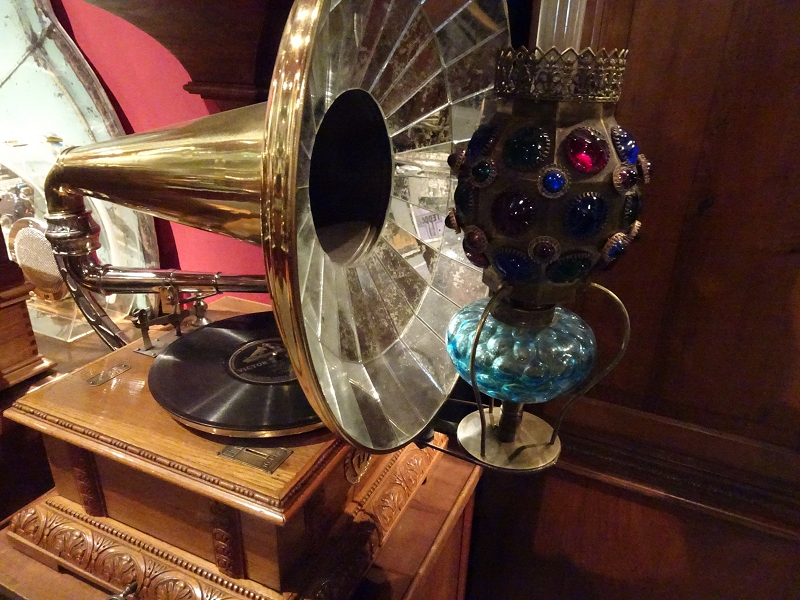 |
| Left: Gramophone with rotating lamp: 1910??
This remarkable gramophone is in the Phonograph Museum in Paris. It has an oil lamp with coloured lenses in its shade that rotates in front of the horn, which is covered with mirror segments to enhance the effect- something like a mirror ball. The lamp is rotated by a belt from the main clockwork motor; the pulley can be seen under the lamp.
You can just see a brass plate to the rear of the gramophone. It reads D.R.G.M. 334473. D.R.G.M. = Deutsches Reichsgebrauchsmuster, a German copyright designation, and 334473 is presumably the number of the copyright. Not much help in finding the manufacturer, but research continues...
There is another brass plate towards the front; this has a slot and is marked 10 PF which presumably mearns '10 Pfennigs' confirming it is a German coin-operated machine for public use.
Author's photograph. I would appreciate it if anyone can identify the manufacturer.
|

PATHE PATHEPHONE REFLEX GRAMOPHONE 1906
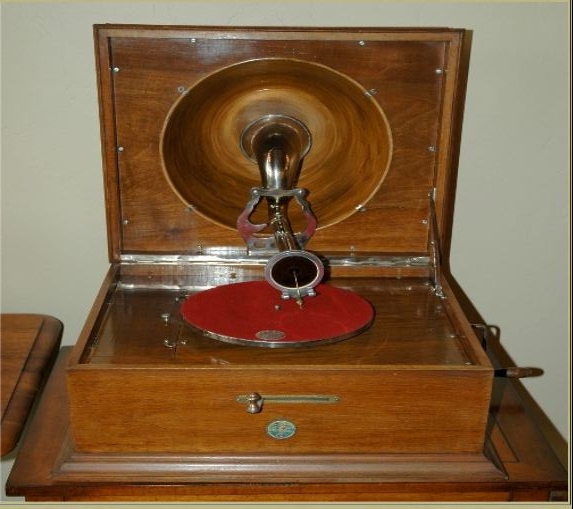 |
| Left: Pathe Pathephone Reflex gramophone: 1906
This design made the horn more compact by 'folding' it; the small silver horn fires the sound at the curved reflector at the rear, and it bounces back into the room. This is also called a 'reflex' system. I assume compactness was the aim, because it certainly doesn't sound any better than a conventional gramophone. The horizontal lever at the front is the stop/start for the turntable.
You can see and hear one on YouTube.
|
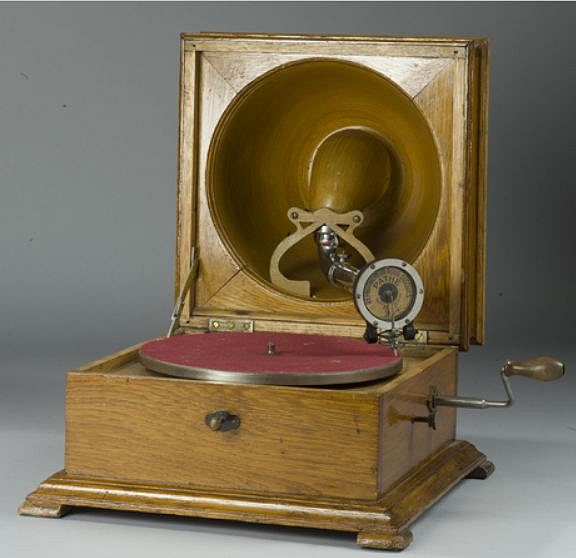 |
| Left: Pathe Pathephone Reflex gramophone: 1906
This another Pathe gramophone with a reflex horn. The odd-shaped metal bracket presumably supports the small horn connected to the reproducer.
What is not too obvious (and Google has been no help) is how the reproducer arm folds away when the lid is closed.
|
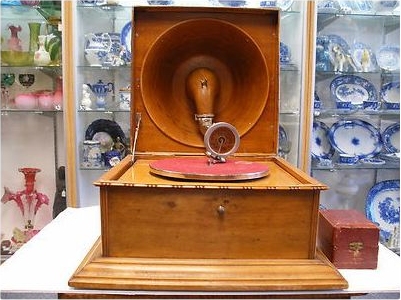 |
| Left: Pathe Pathephone Reflex gramophone: 1906
Another Pathe gramophone with reflex horn, this time without the odd-shaped metal bracket.
|

APOLLO No 2 REFLEX GRAMOPHONE
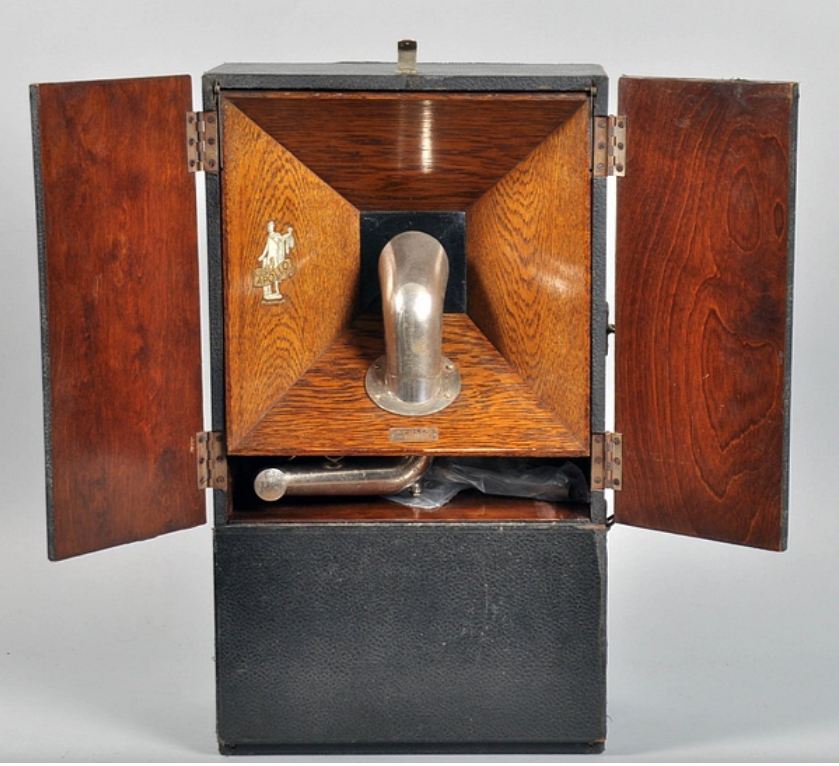 |
| Left: Apollo No 2 Reflex gramophone: circa 1914
This is an Apollo No 2 portable gramophone, with a folded (reflex) horn, utilising US patent 175,453. Apollo gramophones were made by Paillard, a well-known Swiss Company.
The horn has hinged covers, The overall finish is black leatherette; a carrying handle was included. Size 10" x 8".
What is not clear is how you gain access to the record to play it. The horizontal tube below the horn is presumably the tone arm, but no turntable is visible.
You can hear an Apollo reflex gramophone (not the same model) on YouTube.
|
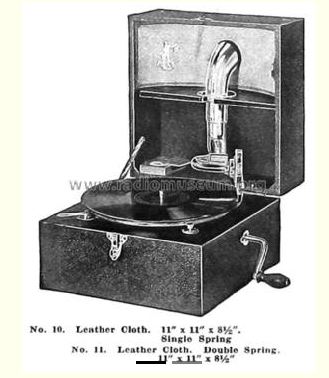 |
| Left: Apollo No 11 Reflex gramophone: circa 1914
This is an Apollo No 11 portable gramophone. For some reason, here only part of the lid is being used as a sound reflector.
|
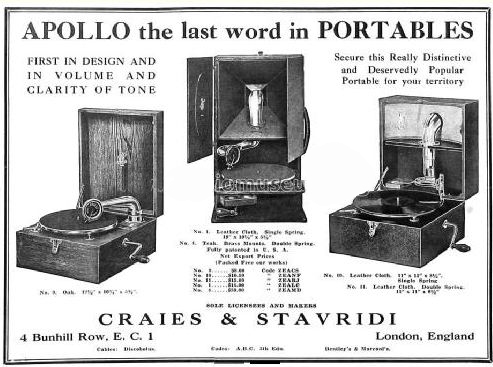 |
| Left: Apollo No 11 Reflex gramophone: circa 1914
Assorted Apollo portable gramophones.
|

THE FONTAPHONE DUAL-HORN GRAMOPHONE: TWO REPRODUCERS
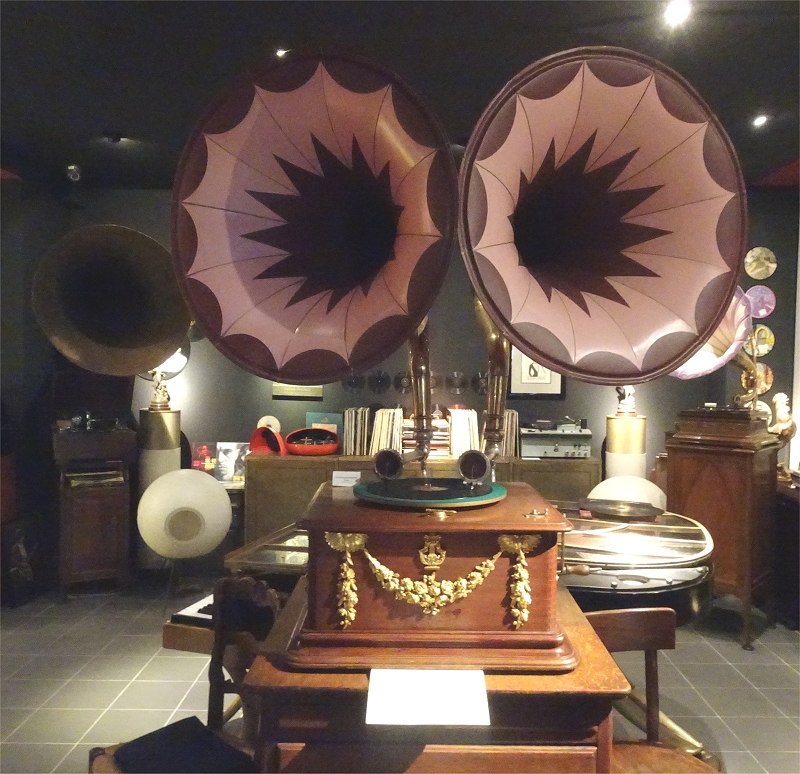 |
| Left: Fontaphone dual-horn gramophone: 1909
This system was supposed to be capable of replacing an orchestra. It was invented by Auguste Fontanon, an Auvergne born in Vergongheon in Haute Loire. It has two separate horns and two separate sound boxes, which sit either side of the centre of the record. Therefore the needles were angled in opposite directions. The result is you get the music, overlaid by a delayed version of the music. This was supposed to create a reverberation effect, but it did not.
The Fontaphone played 120 rpm discs weighing about 1 kilogram. It was sold mainly for professional use: showmen, dance-hall operators and organizers of balls. The discs used hill-and-dale recording. (vertical recording)
The good people at the PHONO Museum demonstrated it to me. What does it sound like? Dreadful. Really bad.
Notice also the machine with the huge horn at rear left. You might think that would give good bass; it did not, when demonstrated. Its largest diameter is about a metre, so the circumference is 3.14 metres; the cut-off frequency is therefore calculated as 109.2 Hz. This will not give good bass.
Author's photograph. Location: the PHONO Museum Paris
|
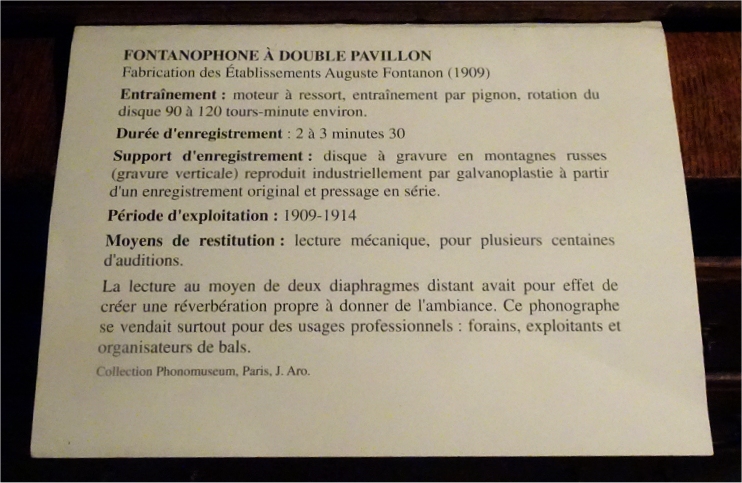 |
| Left: Fontaphone dual-horn gramophone: 1909
This is the description that can be seen in front of the machine in the picture above. We learn that the motor was by spring, (ie clockwork) with pinion drive, and that the speed could be set from 90 to 120 rpm, and that recording duration was from 2 to 3.5 minutes.
The label says that the idea was to "create reverberation proper to the ambiance". What you actually got was a jumble of confused sound, and not at twice the volume- the two acoustic outputs were not in phase and so the increase in volume would only be root-two times, equal to only 3 dB more.
I am baffled that anyone thought the sound acceptable.
Author's photograph. Location: the PHONO Museum Paris
|

PATHEPHONE DUAL-HORN GRAMOPHONE: TWO REPRODUCERS
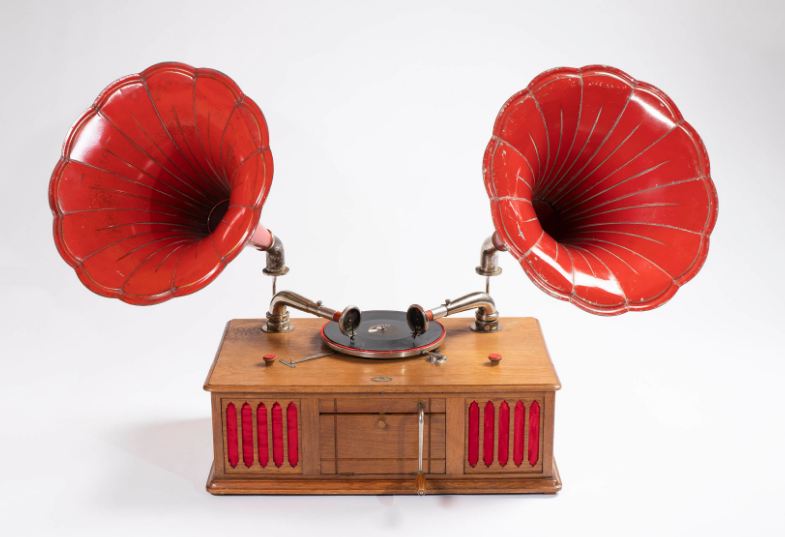 |
| Left: Pathephone Duplex dual-horn gramophone: 1913
This machine is rather mysterious; the two beautifully-coloured horns are stuck on stalks rather than being connected to the tone arms. The horns are here stored rather than in use, and the tone-arms are plugged into alternative horns inside the case, the sound exiting through the vertical slots on each side. There is a knob above each set of slots- volume controls that also allowed you to correct L/R balance?
Perhaps this was another mis-guided attempt at creating reverb? The Museum Staff have so far been unable to find any information on this point. I have heard this machine called the Pathe Duplex Jour-et-Nuit, (Night and Day) the idea being to use the external horns during the day, and the internal horns at night, when less volume was required. I have my doubts; this suggests a domestic machine, but why would you need two horns for domestic use?
|
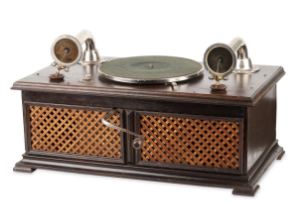 |
| Left: Pathephone Duplex dual-horn gramophone: 1913?
This machine looks very similiar to the one above, except there are no external horns.
You can hear on of these machines on YouTube. Does not sound good.
|
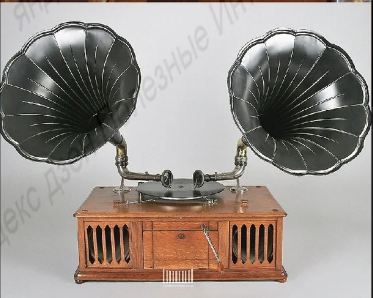 |
| Left: Pathephone Duplex dual-horn gramophone: 1913?
This image was 'found on the web' and I have no direct information about it, but it is pretty obviously another Pathephone Duplex dual-horn gramophone, but this time the horns are attached to the tone-arms. However there are also vertical slots on each side of the case.
I conclude that you could plug the external horns into the tone arms, or, if you wanted a more compact system, you could turn the tone-arms over and plug them into the horn inside the case. Presumably the reproducer (the round thing with the diaphragm and the needle, sometimes called the soundbox) could swivel on the tone-arm.
There are no holes visisble for the tone-arm to plug into, so I suggest that when you remove the horns, you also remove the horn supports, and these are plugged into the holes accessing the internal horns.
The internal horns are visible behind the grilles; they are approx 6 inches in diameter, much smaller than the external horns.
|
 PATHE OLOPHONE DUAL-HORN GRAMOPHONE: TWO REPRODUCERS
PATHE OLOPHONE DUAL-HORN GRAMOPHONE: TWO REPRODUCERS
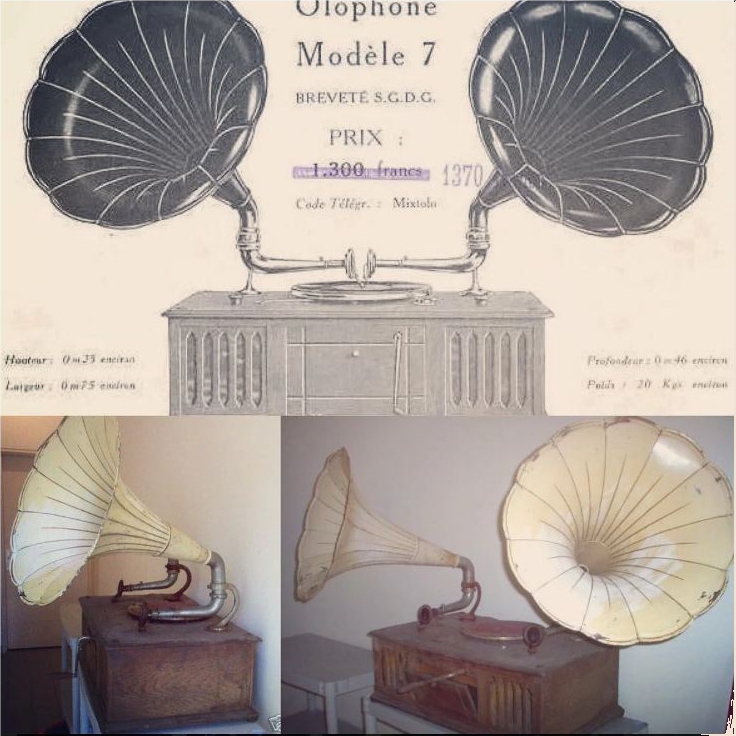 |
| Left: Pathe Olophone dual-horn gramophone: 1918
This looks very much like the Duplex machine above. The horn supports are again plugged into the holes that access the internal horns.
Note the little cabinet with opening lid just under the winding handle.
|

PATHE DUAL-HORN GRAMOPHONE: TWO REPRODUCERS
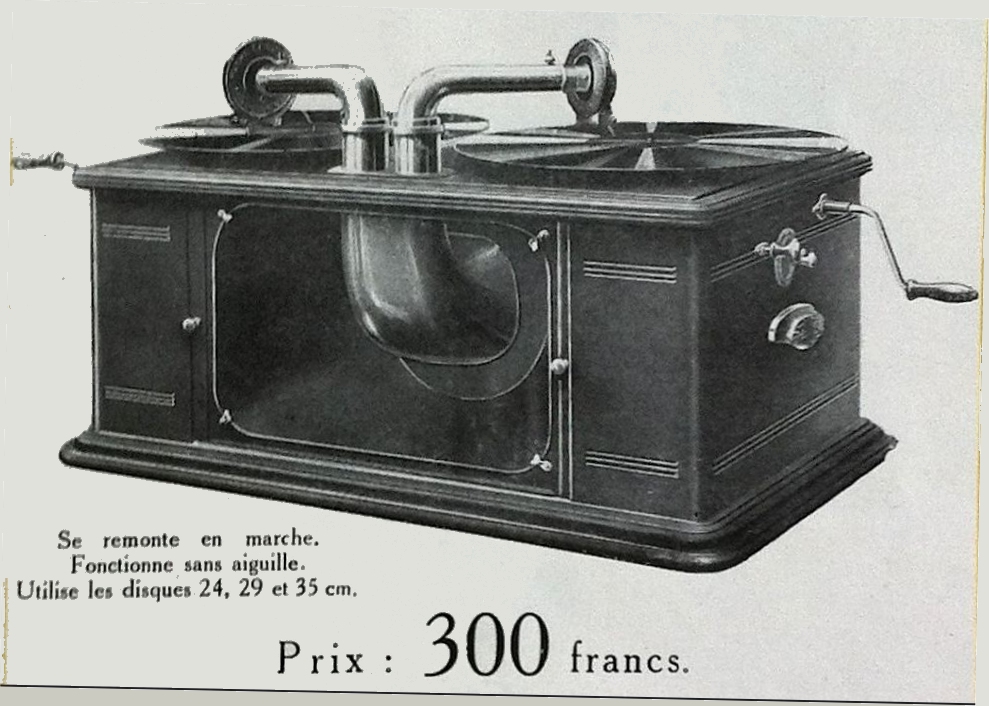 |
| Left: Pathe Duplex Reflex gramophone: 190?
Here the two horns are presumably internal to the cabinet. The word 'reflex' may imply that the horns are in some way folded.
This looks rather like a modern disco setup with two record decks, but no means of crossfading is visible. Se remonte en marche means 'Get back on the move' according to Google Translate, but a better rendering is 'it rewinds itself as it goes'. Clearly it didn't, as that would be perpetual motion. You will note the two turntables have separate motors, and I suggest the idea of this machine is that you wind up one side while the other is playing, so you could have near-continuous music.
Fonctionne sans aiguille means 'Works without a needle' and I have no idea what that means. How?
|

HMV DUAL-HORN GRAMOPHONE: ONE REPRODUCER
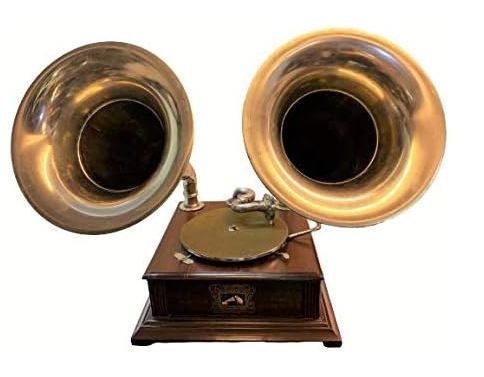 |
| Left: HMV dual-horn gramophone: 190?
This dual-horn gramophone has only one reproducer, so it's not an attempt at reverberation. The tone-arm disappears into the box, where the acoustic path presumably splits to drive the two horns.
It is not currently clear what the point was; perhaps the idea was that you pointed the horns on different directions to better cover a large listening space.
|

DUAL-HORN GRAMOPHONE: ONE REPRODUCER
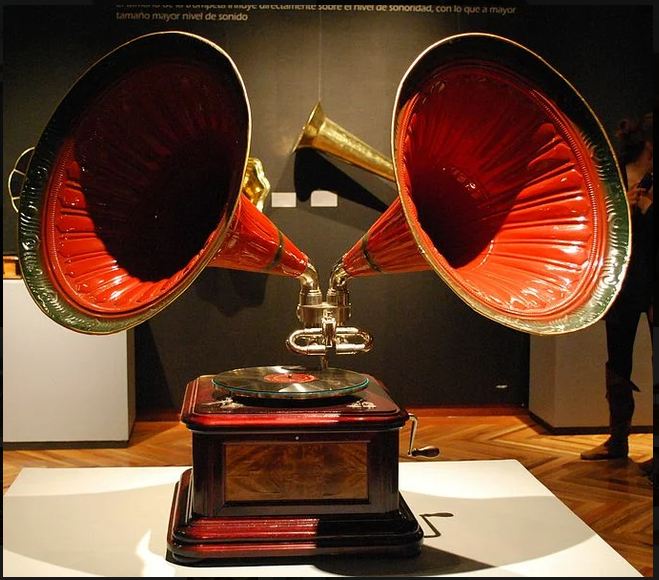 |
| Left: Dual-horn gramophone: 190?
This dual-horn gramophone has only one sound-box, so again this is not an attempt at reverberation. Acoustical output appears to be taken from both sides of the sound-box, implying that the two horns would be out of phase, which if nothing else would much reduce the level of bass frequencies by partial cancellation.
My correspondent Ron tells me: "These dual horn were produced by the German "Rheinland" company around 1920. They also had the smaller version with built in horns. As you mention the sound box has only one membrane, so it looks spectacular and with two horns the sound may be louder but not better."
|

THREE-HORN GRAMOPHONE: THREE REPRODUCERS
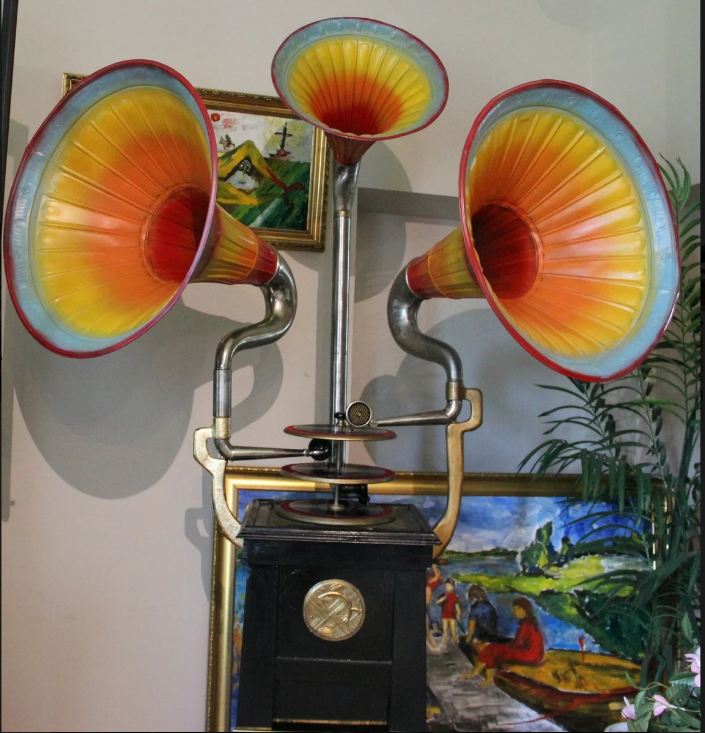 |
| Left: Three-horn gramophone: 190?
This three-horn gramophone apparently has the ability to play three different records at once. It is far from clear what the purpose of this was, but it is certainly a most impressive machine.
Note the central horn is smaller than the outer ones.
No information at all has been found so far. Can anyone help?
|

GERMAN THREE-HORN GRAMOPHONE: ONE REPRODUCER
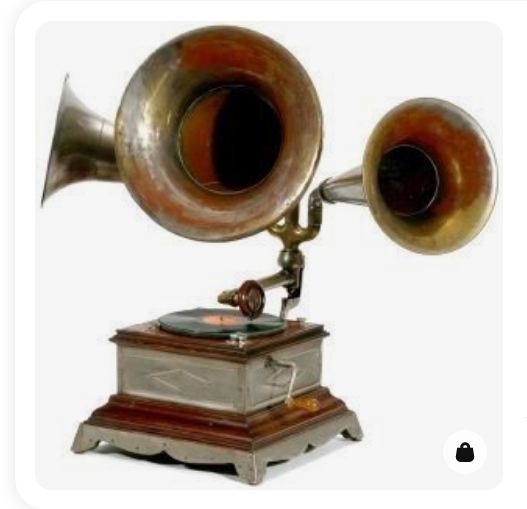 |
| Left: Three-horn gramophone: 190?
This three-horn gramophone has only one reproducer, so it's not another attempt at reverberation. The tone-arm splits into three to drive the three horns; there is one large central horn and two smaller ones each side.
It is not currently clear what the point was; perhaps the idea was that you pointed the horns on different directions to better cover a large listening space.
No information at all has been found so far, except it is believed to be a German machine. Can anyone help?
|

THE PUGH GRAMOPHONE
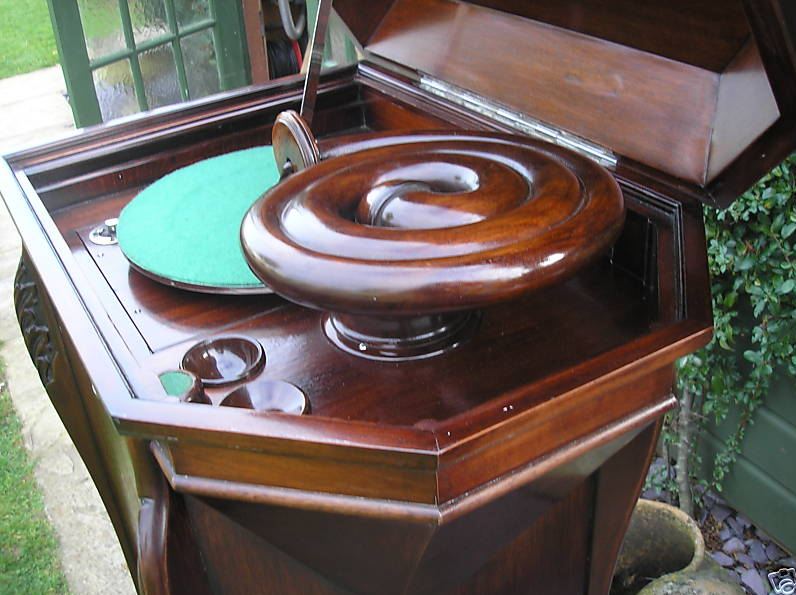 |
| Left: Pugh gramophone: 1918
The defining feature of the Pugh gramophone was its extraordinary tone-arm which consisted of three spiral turns of a wooden tone-arm, and looked something like a resting python.
The inertia of the 'tone-arm' must have been massive. What about the tracking weight?
The motivation here was to make a gramophone without any metal being used in the reproduction process, in the hope this would give a better sound. Apart from the mahogany spiral tone arm, the sound box (reproducer) was constructed wholly of wood including the diaphragm; fibre or thorn needles were used. The hand-built horn was of mahogany. The motor was a large double spring early Garrard.
Patents for which were applied for by George Frederick Pugh in 1918.
|
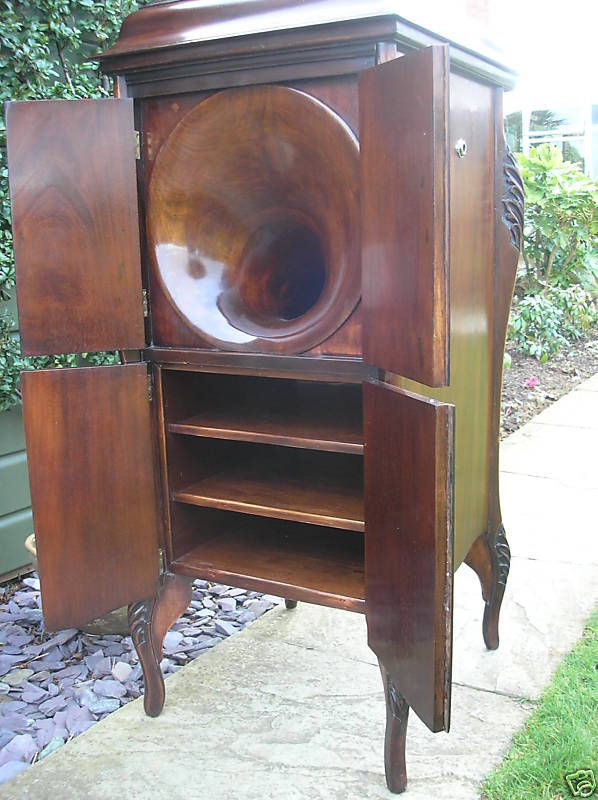 |
| Left: Pugh gramophone: 1918
The rather frightening sight that was revealed when you opened the front doors.
I'm glad it doesn't have teeth.
|

ULTRAPHONE TWO-ARM GRAMOPHONE
 |
| Left: Ultraphone two-arm gramophone: 1922
This image was found on the net, with no accompanying information at all. As with other two-arm gramophones on this page, they were intended to give a reverberation or 'stereo' effect (according to some sources) It would certainly not have been remotely like true stereo. Much later the "Binaural record" developed by Emory Cook gave true stereo using two tone-arms. The two levers attached to the tone-arms controls the delay between the two signals read from the record. At bottom right is the speed control, and just above it is a masked lamp to aid cueing.
I am now told this is an Ultraphone, made by Deutsche Ultraphon AG, Germany 1922.
|
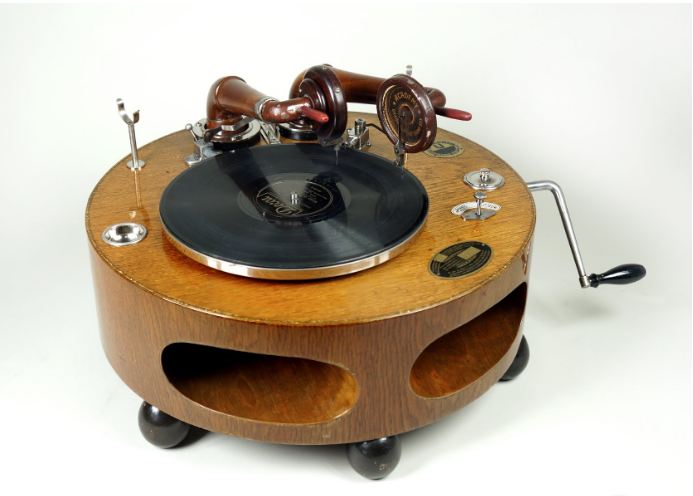 |
| Left: Ultraphone two-arm gramophone: 1922
This version appears to have no linkage between the two arms. There are two separate horns internal to the case.
|

THE QUADRUPLE GRAMOPHONE
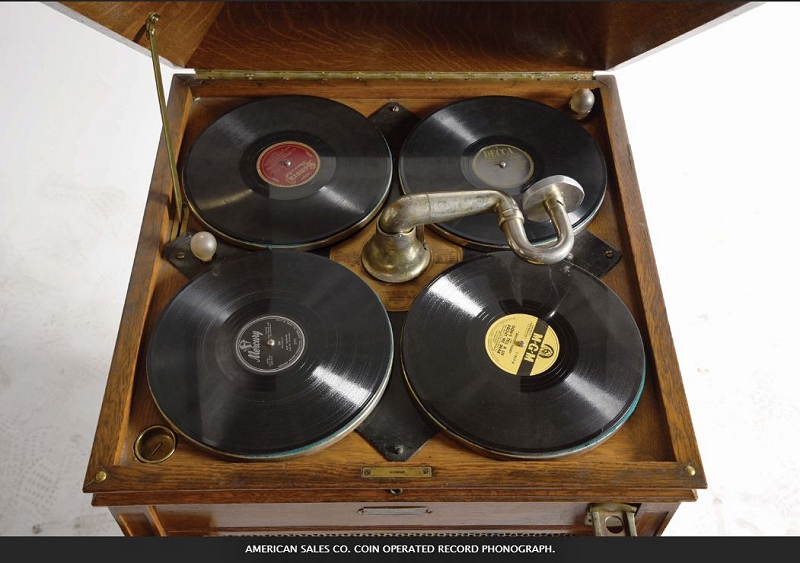 |
| Left: The Quadruple Gramophone: 19??
Just above here are a couple of gramophone with two tone-arms. This beauty has only one tone-arm, but four turntables.
It is a coin operated commercial machine; on inserting a coin or token the four records would be played in turn, the central tone-arm rotating as required. The process could be viewed through the glass top. The turntables were electrically driven.
It was made by the American Sales Company which was located at 932 Wrightwood Ave, in Chicago, ILL. This may be the same company.
This example, which was sold at auction, carries the words "Daily Concert Phone" and the serial number 307. The company took out patents in 1916, 1923, and 1926.
|

VIOLIN-HORN GRAMOPHONE
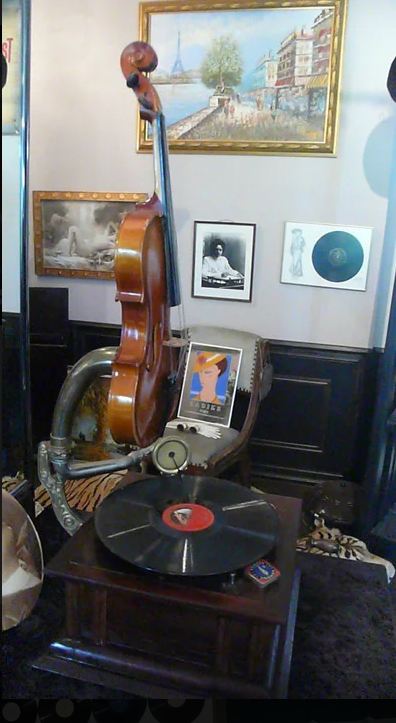 |
| Left: Violin-horn Gramophone: 19??
Another image found on the net, with no accompanying information at all. Now, just what is going on here? It appears that the gramophone horn has been removed and replaced by a violin (or is it a viola?) for some reason. Now this might be appropriate for recordings that consist only of violins, but even then there is the objection that since the sound of the strings has already been modified by the body of the real violin, at the time of playing, doing it again is not going to be an improvement.
An image search has yielded nothing whatsoever.
|

THE PALMODIAN VIOLIN-HORN GRAMOPHONE
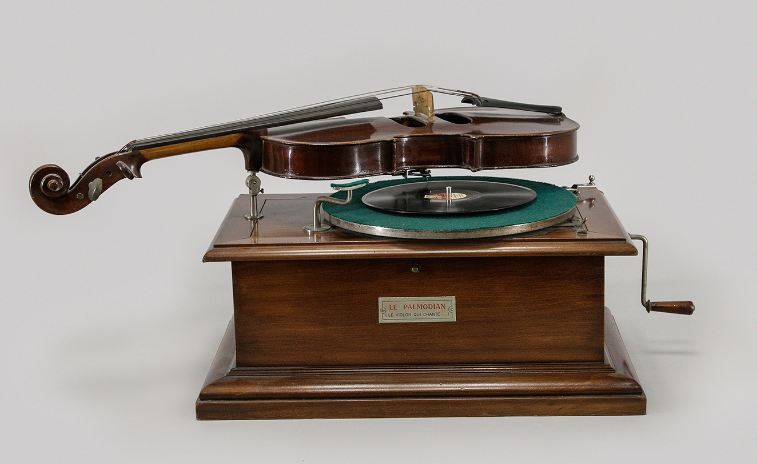 |
| Left: The Palmodian Violin-horn Gramophone: 1903
Just when you think you've seen the maddest gramophones ever, something like this comes along. This is a Palmodian gramophone, made in France in 1919. "The Violin That Sings!" It was invented and patented in 1903 by violin maker Herbert Reginald Payne and engineer Thomas Broadbent (of Aylesbury, Buckinghamshire, in Great Britain) They secured British patent No 3723.
The needle is mounted on a small metal arm which presses on the back of the violin.
Note the two supports for the violin.
I find it difficult to believe that this sounded anything other than awful.
|
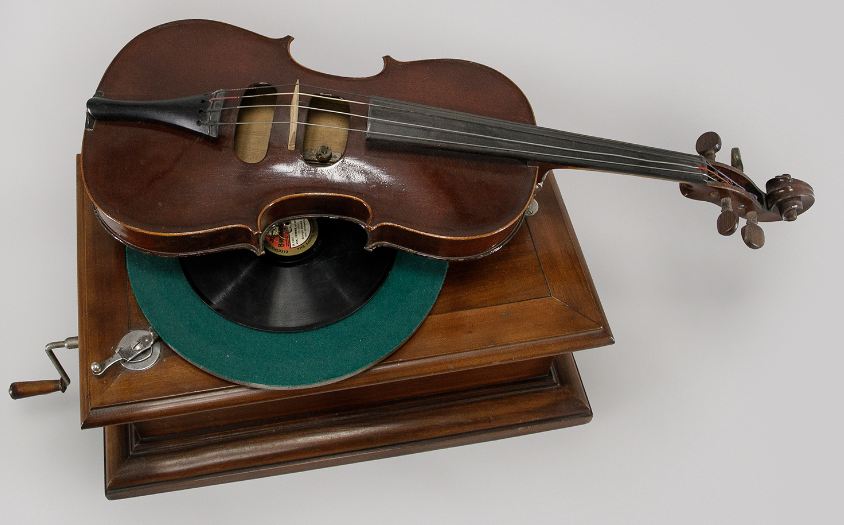 |
| Left: The Palmodian Violin-horn Gramophone: 1903
Note that the strings and tuning-pegs are still in place, possibly giving a resonance effect; I do not think it would have enhanced the listening experience.
Note also the holes cut out either side of the bridge to let the sound out.
|
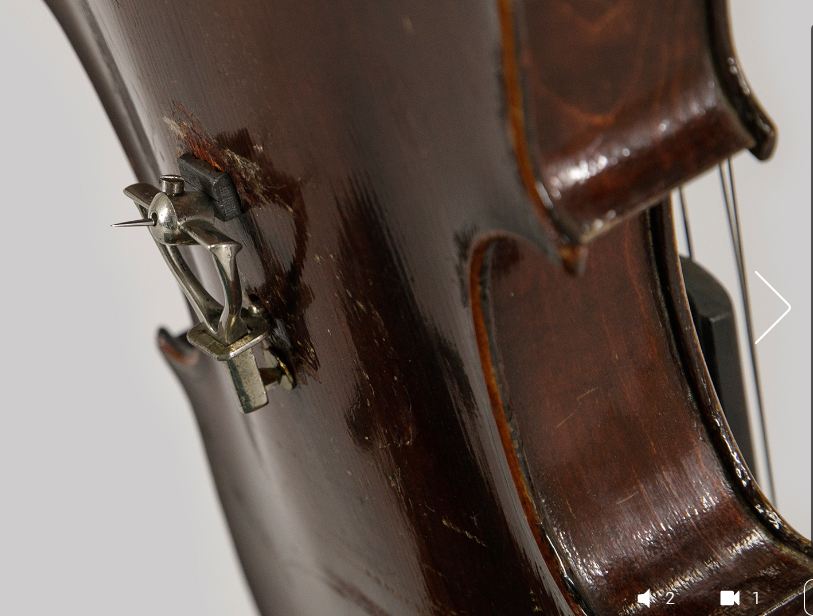 |
| Left: The Palmodian Violin-horn Gramophone: 1903
This shows the underneath of the violin, with the metal arm that carries the needle.
One imagines that only the cheapest of violins would be used for a set-up like this. It does not seem good employment for a Stradivarius violin, especially if you have to cut holes in it.
|
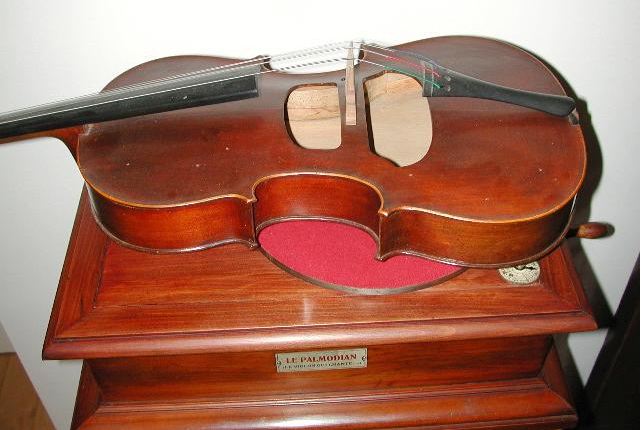 |
| Left: The Palmodian Violin-horn Gramophone: 1903
This is a similar construction to the one above, but it is not the same machine. There appears to be only one support for the violin. (Not visible)
|

THE FAKE (?) PALMODIAN VIOLIN-HORN GRAMOPHONE
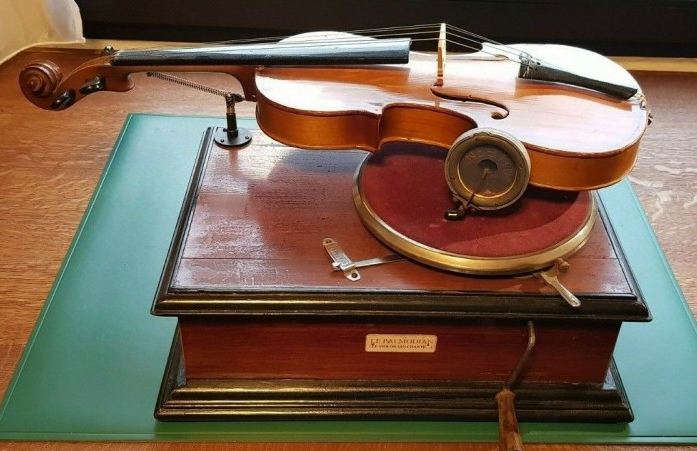 |
| Left: The Palmodian Violin-horn Gramophone: 1903
This appears to be a very rough attempt at a fake Palmodian, made by sticking a reproducer to the side of a violin. It actually seems unlikely that anyone would be fooled by this; I suspect it was done for a laugh rather than with serious intent to deceive or defraud.
There are no holes in the top of the violin to let the sound out, as in a real Palmodian, and I'm prepared to bet it doesn't work at all well, if it works at all.
The nameplate appears to be genuine and says 'Le Palmodian'. The text beneath is not legible.
There is more info here.
|

THE RESONATOR-HORN GRAMOPHONE
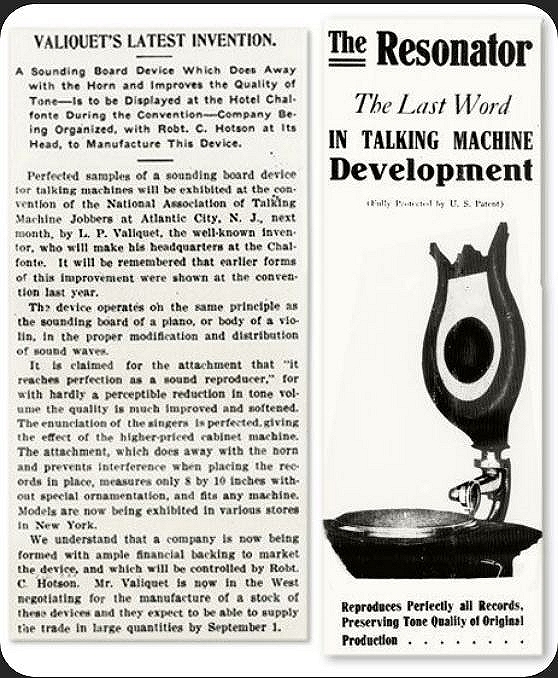 |
| Left: The Resonator gramophone: 1907?
On the left you can see the extravagant claims made for this invention, which looks rather like a small gramophone horn combined with a toilet seat; presumably it's supposed to be in the shspe of a lyre.
How it was supposed to give better reproduction is not clear. Usually resonance is the last thing you want in audio.
Louis P Valiquet was born in Quebec, and is known to Google. See US Patent 840,974, 8 Jan 1907 for an Automatically-operated talking-machine. He also designed a typewriter called the American, also known as the Globe, and marketed in Europe as the Champignon. (French for "Mushroom") Some more typewriter info here.
There is a bit more info on the Resonator here.
|
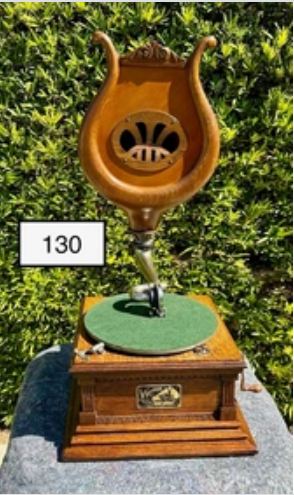 |
| Left: The Resonator gramophone: 1907?
Here is a photo of a real example. It was Lot 130 in an auction.
This is believed to be a Victor M Phonograph with a Valiquet Resonator fitted.
De gustibus, but I consider this to be one ugly gramophone.
|
 |
| Left: As for Resonator gramophone rights: 1910
In the issue of The Talking Machine World in which this ad appeared, Valiquet said in four other places that he wished to sell the foreign rights. This smacks of desperation.
Source: The Talking Machine World, Vol 6 No 9, 15 Sept 1910
|

COMBINED GRAMOPHONE AND LAMP
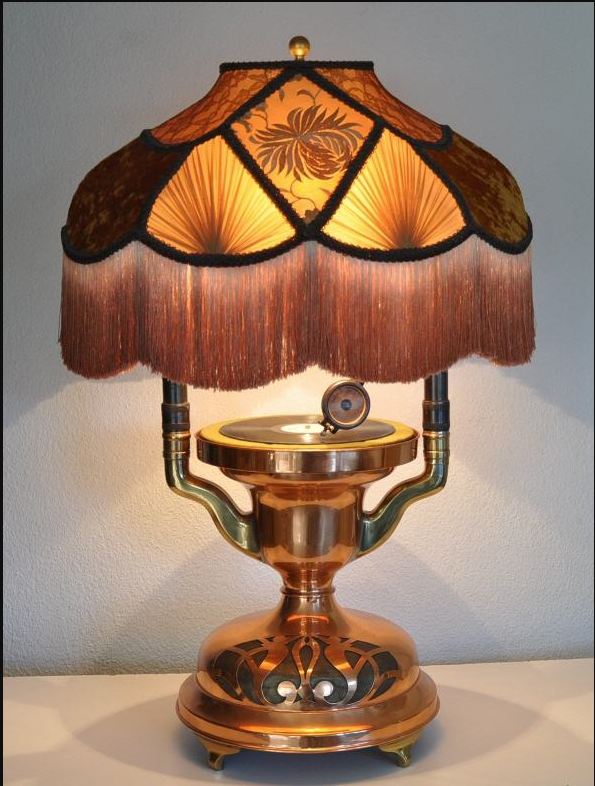 |
| Left: Combined gramophone and lamp: 1920s
This is a Fairy Phono Lamp made by the Endlessgraph Co. It appears the sound goes down the two vertical tubes and comes out of a horn inside the base. The pipework is copper.
The operation of the lamp and gramophone motor are believed to be electric.
|

COMBINED GRAMOPHONE AND LAMP
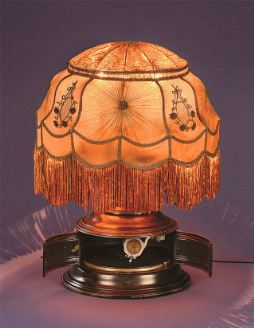 |
| Left: Combined gramophone and lamp: 1920s
This is a Phono Lamp made by the Edison Co. Opening the doors presumably creates a crude sort of horn.
The operation of the lamp and gramophone motor are electric.
|

THE EIFFEL TOWER GRAMOPHONE AND LAMP
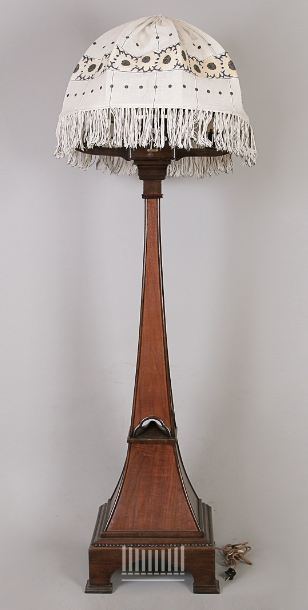 |
| Left: The Eiffel Tower Combined Gramophone and Lamp: 1910
This truly remarkable gramophone really does have a downward facing horn, unlike this one. The tapering mahogany body acts as the horn and the soud emerges from the grilles at the bottom. It weighs 10 kg.
It was made by J. Prantner Musikhaus (which is unknown to Google) in Bregenz in the South Tyrol of Austria around 1910.
There is a bit more info here.
It is not clear if this was a deliberate attempt to model the Eiffel Tower or if the resemblance just resulted from the shape of the horn.
|
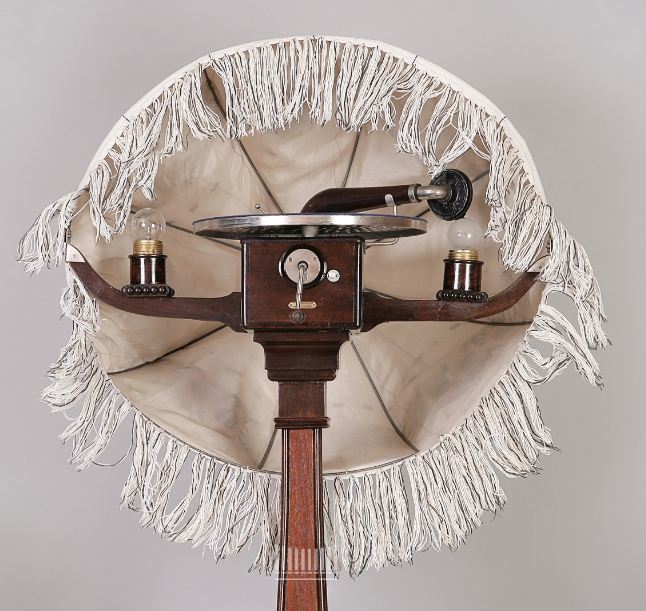 |
| Left: The Eiffel Tower Combined Gramophone and Lamp: 1910
The lampshade swivels backwards to give access to the turntable. Visible are the winding handle and next to it is the pin for stop/start control.
An image search has yielded nothing. Googling "eiffel tower gramophone" gave no useful results.
|

COMBINED GRAMOPHONE AND LAMP
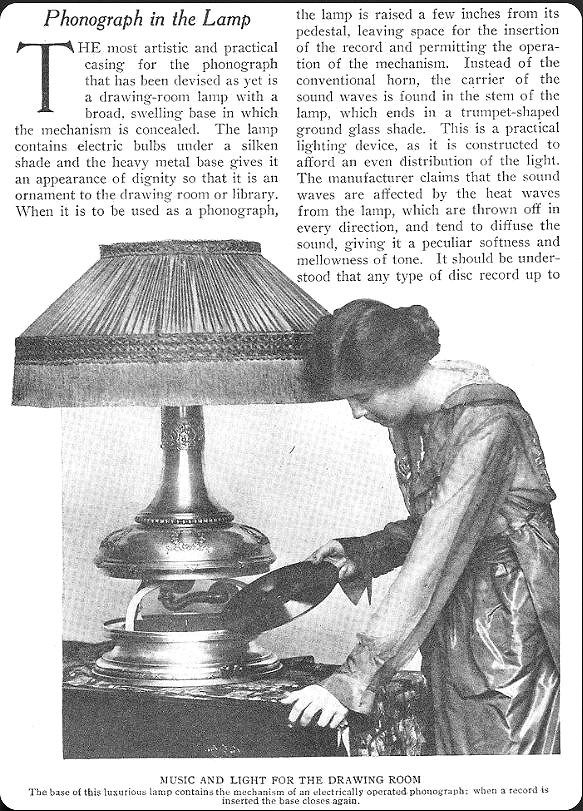 |
| Left: Combined gramophone and lamp: 1920s
This bizarre combined gramophone and lamp has the horn facing upwards, and the lampshade is attached to its rim.
The sound waves were NOT affected by the heat from the lamp; pure nonsense.
Source: unknown.
|

COMBINED GRAMOPHONE AND MANDOLIN
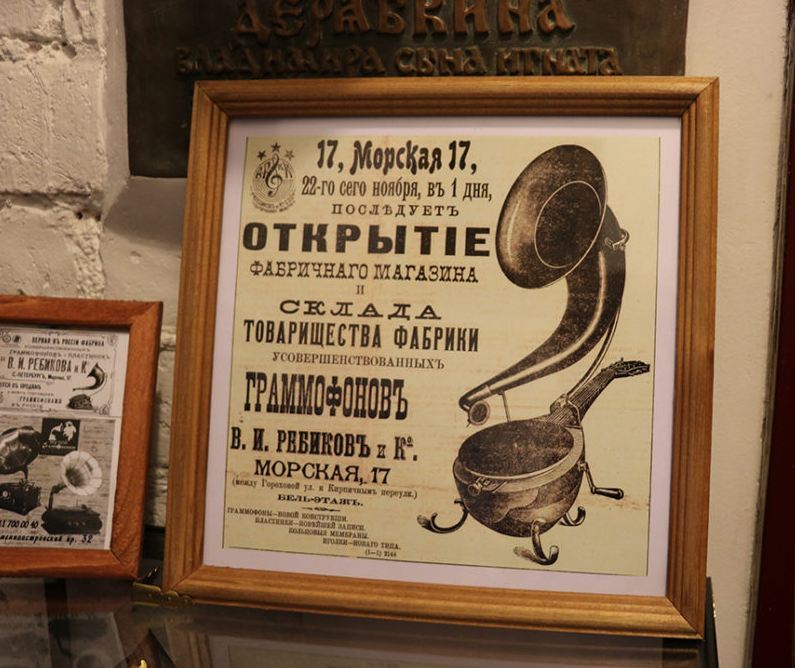 |
| Left: Combined gramophone and mandolin: 19??
This is an exhibit in the Saint Petersburg Museum-Of-Gramophones-And-Phonographs. It appears to be advertising a combination of a mandolin (note the neck at the rear) and a gramophone.
An image search has yielded nothing. Googling "mandoline gramophone" also gave no results. Does anyone know any more?
|

THE PETER PAN COMBINED GRAMOPHONE AND CLOCK
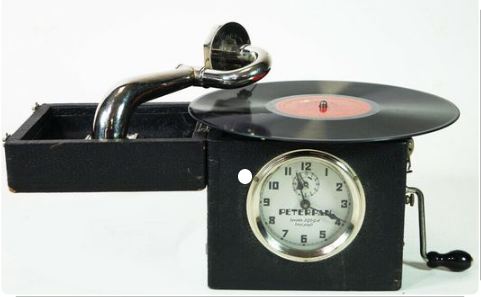 |
| Left: Peter Pan combined gramophone and clock: 1927
Sporrophon were not the only people who thought that a combined gramophone and clock was a good idea. (see just below) This machine is not only a gramophone and a clock , but is also portable. This gramophone-clock had an alarm function. After winding up the clock and the gramophone motor, and setting the alarm, the gramophone would start playing the record at the set time. It was made in England and patented in France. It had with a Swiss motor and diaphragm, probably by Paillard.
You can see and hear an example on YouTube.
|
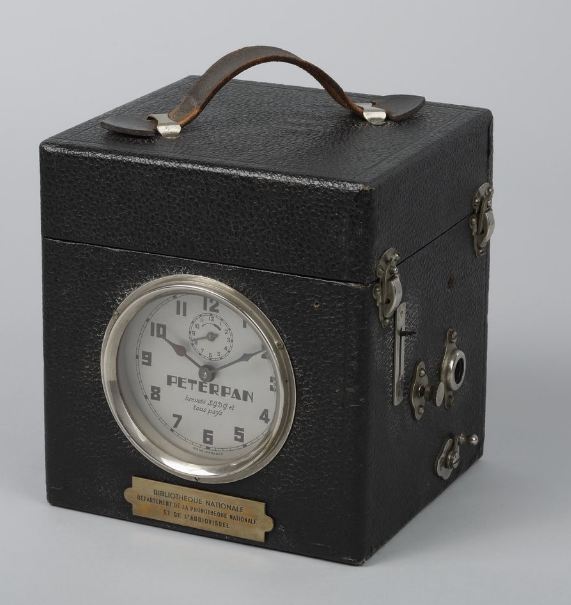 |
| Left: Peter Pan combined gramophone and clock: 1927
The combined gramophone clock with the case closed.
It is not wholly clear to me why you would want to carry around an alarm-gramophone rather than just an alarm clock.
There is more info here
|
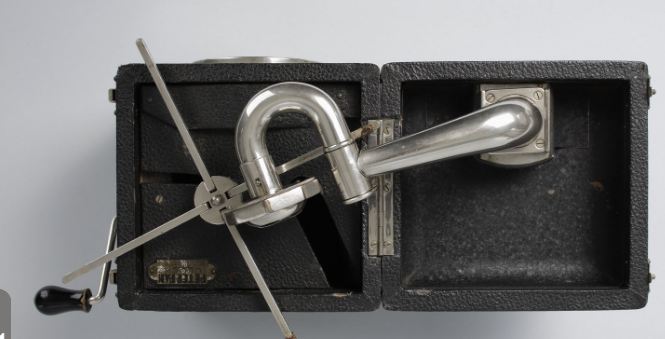 |
| Left: Peter Pan combined gramophone and clock: 1927
The absence of a horn is perplexing. It appears that here the lid must have acted as a reflector in the same way as the Pathe Reflex.
However this video on YouTube shows a version with a small folding Rexine horn.
The 'turntable' consisted of four folding arms to support the record.
|

THE SPORROPHON COMBINED GRAMOPHONE AND CLOCK
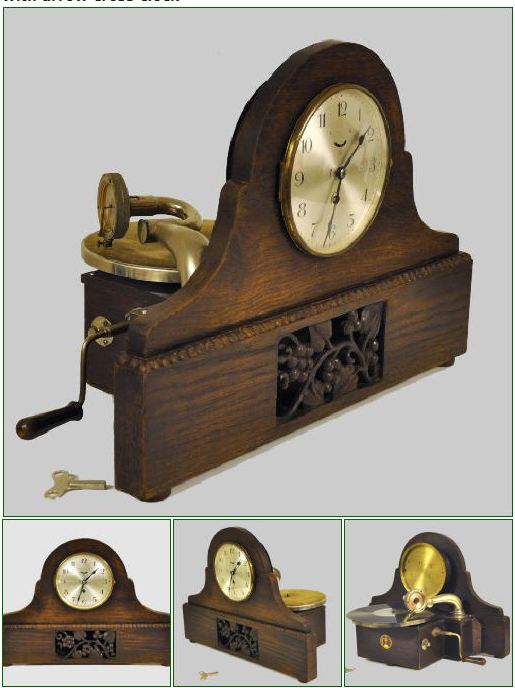 |
| Left: Sporrophon combined gramophone and clock: 1925
Some people just seem to like combining functions that are not obviously connected. Just above there is a combined gramophone and mandolin. This is a combined gramophone and clock, made by the Sporrophon company. It is not currently known if it had an alarm-clock feature.
The horn is internal to the cabinet, and the sound comes out through the grille at the front.
|

THE SPORROPHON WEIGHT-DRIVEN GRAMOPHONE
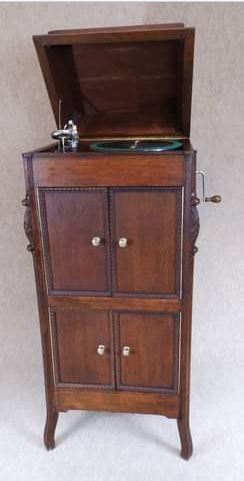 |
| Left: Sporrophon combined gramophone and clock: 1925
Sporrophon also made a gramophone powered by a falling 10 kg weight, using as a slogan "No spring breakage because there is no spring". There is some info on it here. This seems like a relatively sensible idea, guaranteeing a steady driving force, but it is not known how long the drive would run for. Note conventional winding handle to the right.
The horn is internal to the cabinet.
|
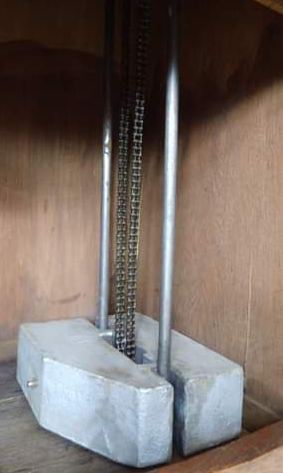 |
| Left: Sporrophon combined gramophone and clock: 1925
This shows the two falling weights that drove the gramophone. They appear to be made of concrete.
|

THE SLOT HORN GRAMOPHONE
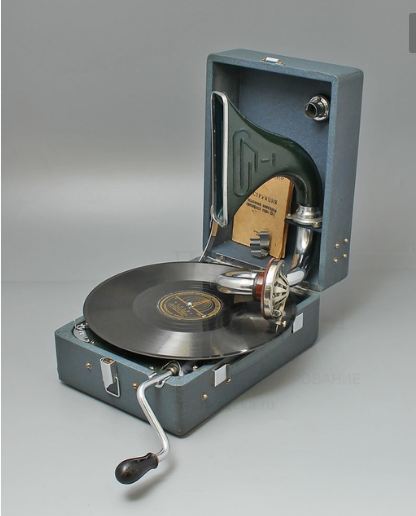 |
| Left: Slot horn gramophone: 1950
The Museum Staff had some difficulty finding out anything about this odd portable gramophone, which looks as if it breaks all the rules of horn design. Unfortunately the text on the booklet in the lid is not legible.
Any information would be gratefully received.
|
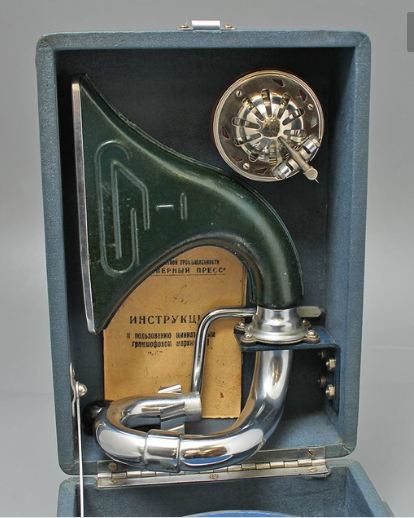 |
| Left: Slot horn gramophone: 1950
This picture makes it clear the gramophone was a Russian design. Can anyone translate the text on the booklet?
There are more photographs here.
|
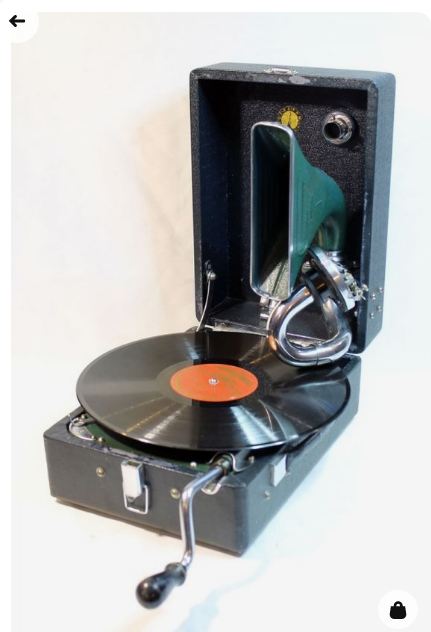 |
| Left: Slot horn gramophone: 1950
It emerges this gramophone is a Model SP-1, manufactured in 1950 by the "NORTHERN PRESS" metal stamping plant, in Leningrad, Russia. It has also been described as an Artel Grammofon, Model 1; with ARTEL GRAMMOPHON LENINGRAD embossed on the reproducer.
The Severny Press plant was created in January 1932 as the metal stamping shop and tinplate chromolithography section of the Nevgvozd plant.
|

PIXIE GRIPPA GRAMOPHONE
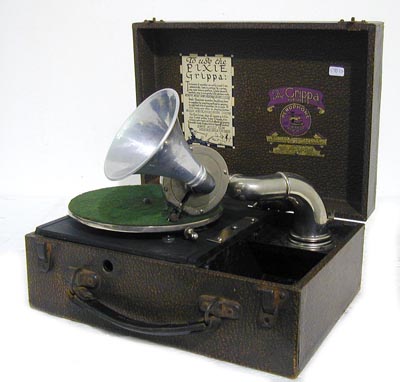 |
| Left: Pixie Grippa gramophone: 1909
The Pixie Grippa was a compact portable gramophone with the unusual arrangement of a small extra horn on the back of the soundbox; the main horn was folded inside the cabinet. According to an owner "it actually sounds very good." It is about 10" wide.
Although not in use today, the term "grip" referred to a small hand-held suitcase or bag.
It is not known what purpose the extra horn was intended to serve; was it supposed to be something like a crossover, giving superior reproduction of high frequencies?
You can hear a Pixie Grippa on YouTube.
|
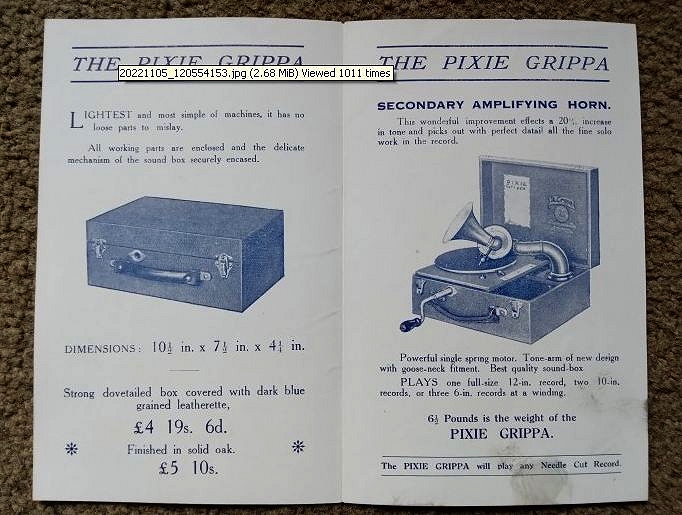 |
| Left: Pixie Grippa gramophone: 1909
The advert states: "This wonderful improvement effects a 20% increase in tone (What on earth is that supposed to mean?) and picks out with perfect detail all the fine solo work in the record." Sounds like a modern hifi magazine woffling on, and that is not a complement.
The Pixie Grippa sounds like it might be useful for dealing with aggressive fairyfolk.
|

THE CLIFTOPHONE
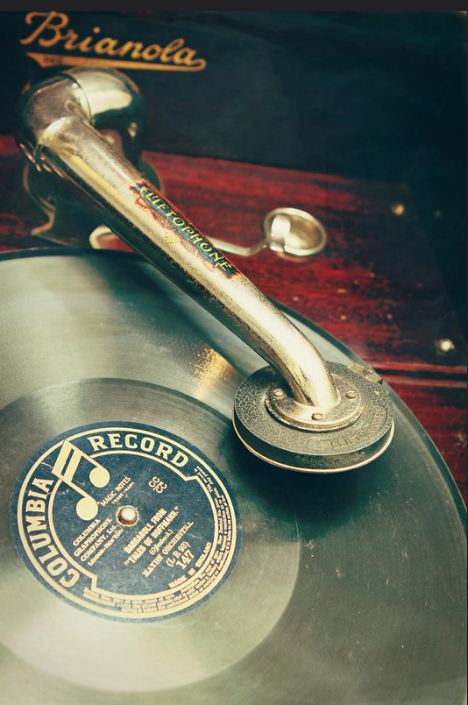 |
| Left: Cliftophone gramophone: 1922
The unusual feature of the Cliftophone was its horizontal reproducer. The needle bar has a right angle at its pivot (conventional ones are straight) so that the lateral movement of the needle is converted to vertical movement at the diaphragm. There are opinions about that sound quality was not as good as for a standard gramophone, but when Gramophone magazine did some comparative tests the Cliftophone was much liked.
There is more information here.
Note the word 'Brianola' in the background, which is unknown to Google. To English ears it sounds vaguely humorous, a 'brian' being a dim or inept person. See the Life of Brian.
|
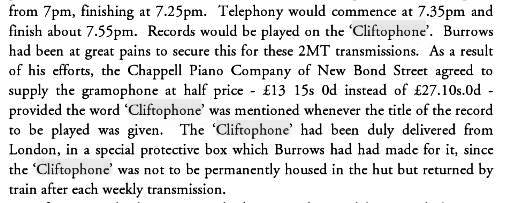 |
| Left: Cliftophone gramophone: 1922
A Cliftophone was used to play records for the early wireless broadcasting experiments at 2MT in 1922. This extract shows that it was considered of high quality.
Source: The Emergence of Broadcasting in Britain, by Brian Hennessy.
|

THE BELL GRAMOPHONE
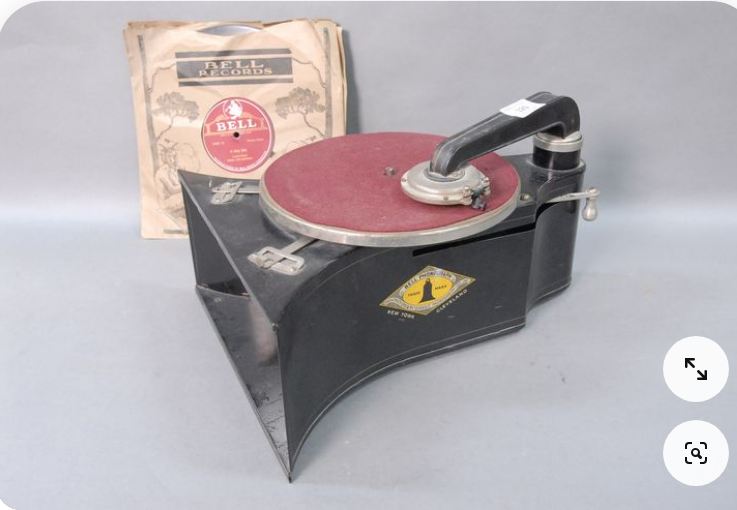 |
| Left: Bell gramophone: 1916
This is a Bell gramophone made by the Durable Phonograph Co Inc of Cleveland, Ohio in 1916. The salient features of this gramophone are the downward facing reproducer (like the Cliftophone just above) and the bell-like shape of the casing that forms an internal horn. The start/stop lever is on the left, and the speed adjusting lever with a scale marked “S 78 F” is on the right, of the front of the case.
The turntable is driven by a spring motor that is would by moving the silver lever back and forth, rather than by turning a crank; the lever approach may have been adopted because it was more compact.
The name Bell was probably inspired by the plan view of the gramophone, which is bell-shaped.
Judging by the label in the background, Bell were also in the business of manufacturing records.
|
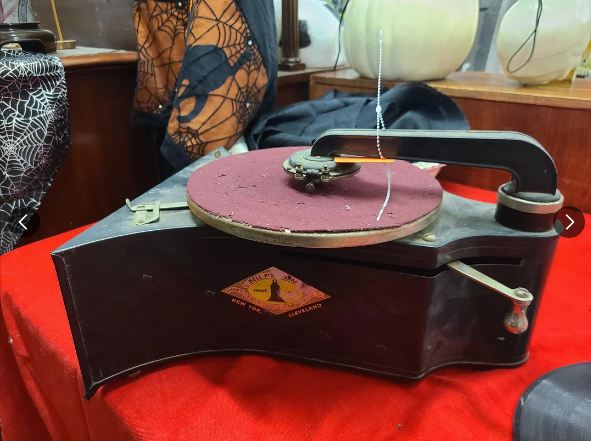 |
| Left: Bell gramophone: 1916
The Durable Phonograph Co. was incorporated in April 1916, for $1,000 in New York by J O Murphy, Russell Goldman and A G Thaanum. Google gives no other information.
There is a bit more info here.
|

THE MIKIPHONE
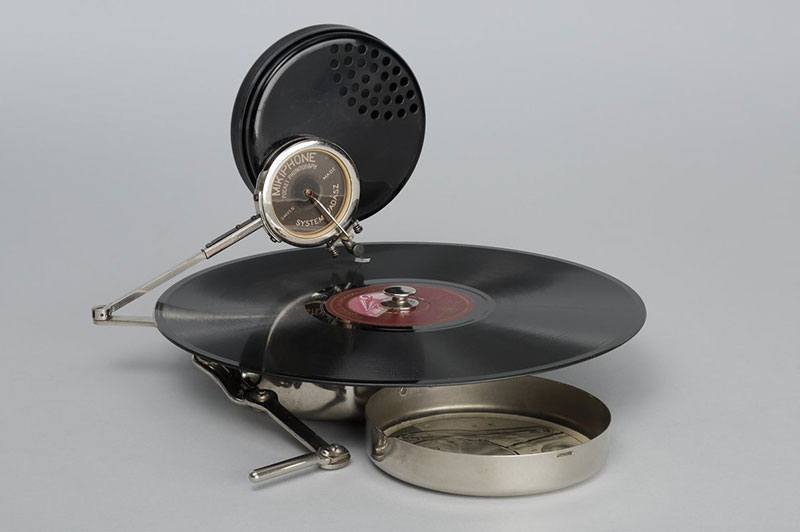 |
| Left: Mikiphone portable gramophone: 1924
This very portable gramophone was manufactured by E. Paillard Cie, a well-known Swiss Company we have met before in this gallery, from 1924 to 1927. The design was by the Hungarian brothers Nicolás and Etienne Vadás. The writing on the reproducer says 'System Vagasz'; Googling that yields nothing.
The diameter of the closed gramophone is approx 11.5 cm, and the weight slightly less than a kilo; quite a hefty object. It could play 25 cm records.
There is more information here; the site includes a video of a Mikiphone being prepared and played. It sounds better than you might expect.
Note the record clamp in the centre of the record label; this was presumably to prevent slipping. Vinyl enthusiasts today still use them; how little progress they have made.
|
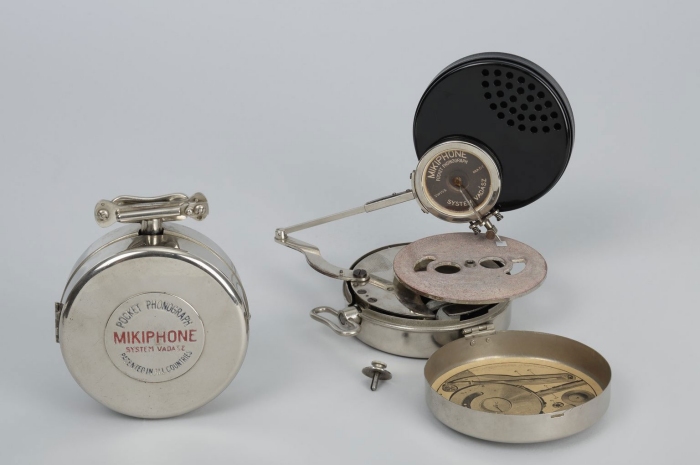 |
| Left: Mikiphone portable gramophone: 1924
The black round thing is a perforated Bakelite resonator, which presumably helps to match the impedance of the reproducer to the impedance of the air. Since its weight is carried on the skeletal tonearm, the tracking force must have been considerable.
There is more information here.
|
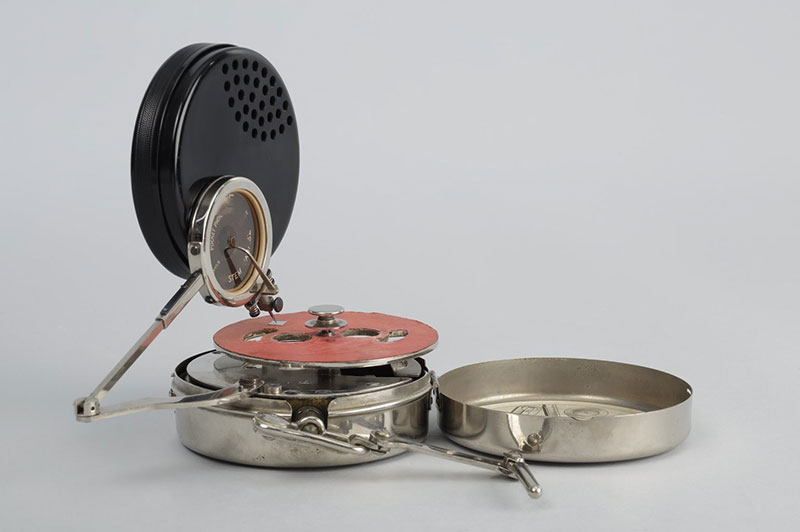 |
| Left: Mikiphone portable gramophone: 1924
The Mikiphone was marketed with the slogan "The smallest gramophone in the world".
There is some further information here.
|
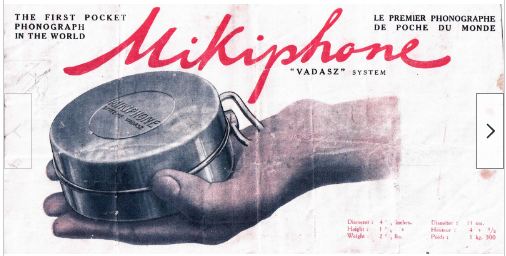 |
| Left: Mikiphone portable gramophone: 1924
Another slogan was "The first pocket phonograph in the world".
There is some further information here.
|

THE GYPSY PORTABLE GRAMOPHONE
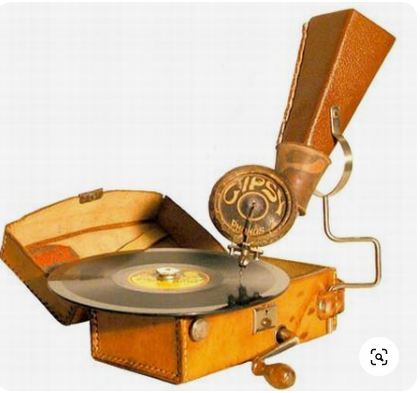 |
| Left: The Gypsy portable Gramophone: 1930
The Gypsy portable was a rather rough-looking design from the Phonos company of Paris, France. The rectangular-section horn looks very crude; it was designed to fold up for transport. It was connected to the reproducer by a rubber tube.
There is more information here.
You can see and hear one working on YouTube.
|

THE PRIMAPHONE
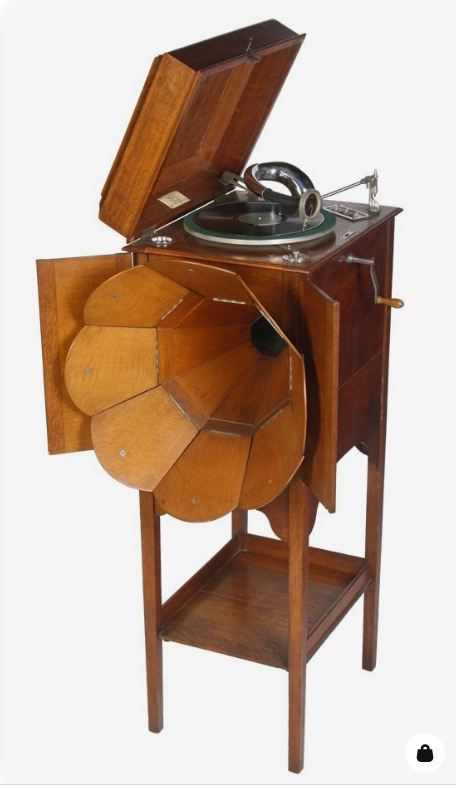 |
| Left: The Primaphone: 1912
The Primaphone had the unusual feature of an internal horn with an outside extension that could be folded inwards to save space when not in use.
The Primaphone Cabinet Grand was made in London between 1912 and 1914. The concept of an opening horn was patented by Joseph M Landon of South Norwood, London; he received US Patent 1,029,502 in June 1912. Otherwise he is unknown to Google.
|
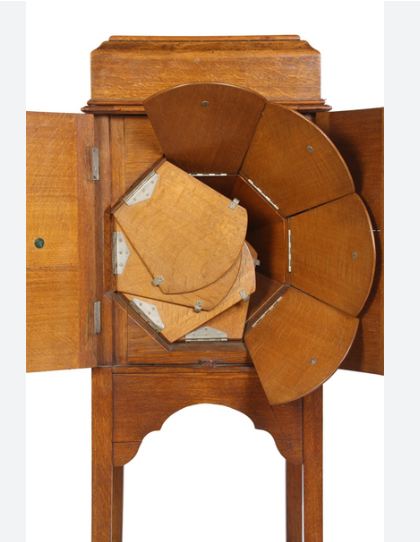 |
| Left: The Primaphone: 1912
Showing how the petals of the external horn holded inwards on metal hinges; they were numbered so they could be folded in the correct sequence. When they were all folded the two doors could be closed.
|
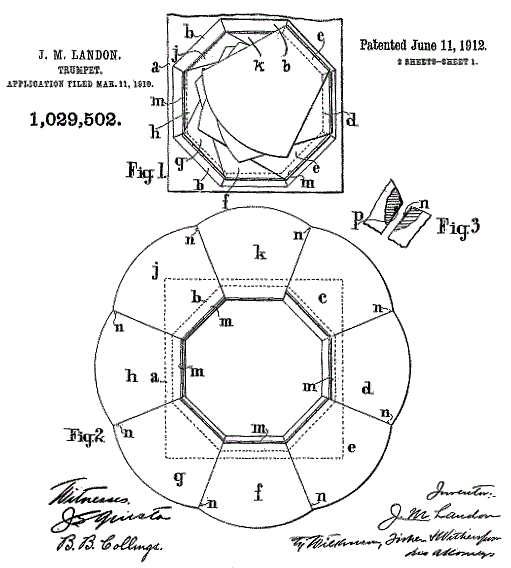 |
| Left: The Primaphone: 1912
For some reason the patent is titled 'Trumpet' rather than 'Horn'. There is some quite complicated proportioning of the petals and their hinges to allow proper folding.
Source: US patent 1,029,502 of June 1912
|
 |
| Left: The Primaphone: 1912
This shows how the horn was routed inside the cabinet.
Source: US patent 1,029,502 of June 1912
|

A BIG-HORN GRAMOPHONE
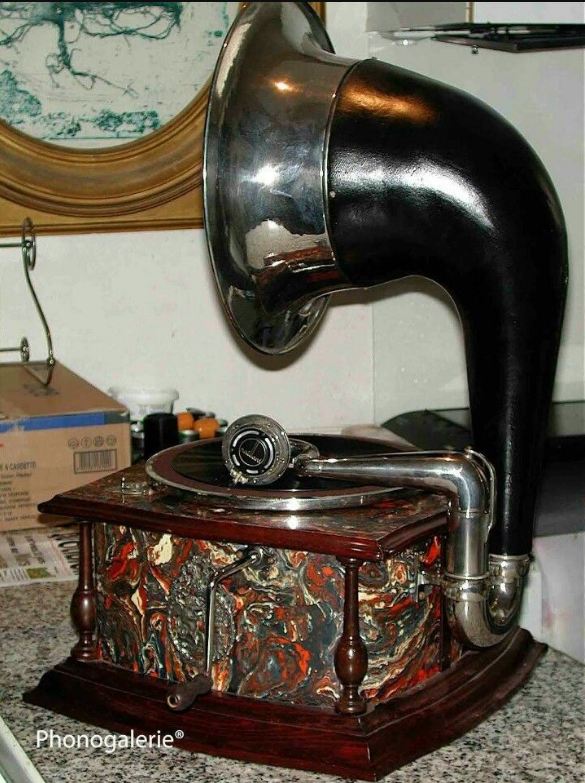 |
| Left: Big-horn Gramophone: 19??
Nothing is known about this highly decorated gramophone, but I was impressed by its enormous (and rather threatening) horn. Not a machine to mess with.
|

THE EMG EXPERT SENIOR GRAMOPHONE
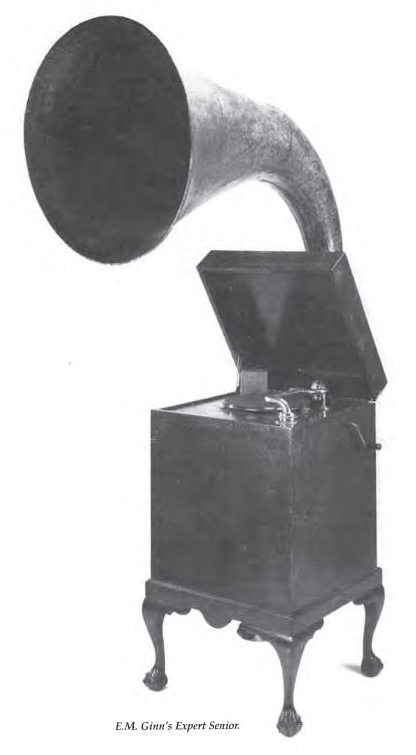 |
| Left: EMG Expert Senior big-horn Gramophone: 1930
EMG were a small company British started by Ellis Michael Ginn; they made high class gramophones, of which the Expert series had unusually large horns in pursuit of improved audio quality.
The long and complicated history of EMG can be found here.
|
 |
| Left: EMG XB Gramophone with Oversize Horn: 1934
In 1934 MMG were offering gramophones with even larger 'All-Range' horns that varied from three feet to four-feet six diameter at the mouth. Apparently some customers ordered these horns but then found they would not fit through the front door of their house.
"These vast horns were the last exotic flowers of the acoustic age, and were, before many years were to pass, destined to join the Dodo and the dinosaur. The end of the acoustic age was now in sight."
|

THE DOWNWARD-HORN GRAMOPHONE
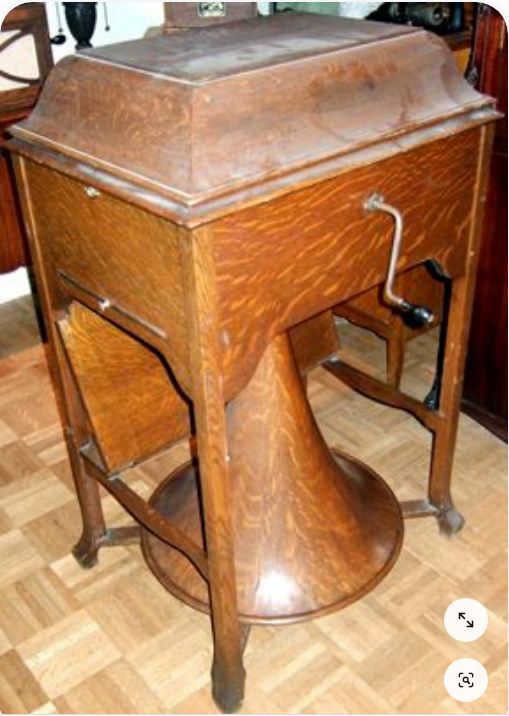 |
| Left: Victor “Schoolhouse” Phonograph with downward-directed horn? 1915
This picture is misleading. It looks as though someone thought a horn facing downward towards the floor would give good reproduction, which I think is fairly clear it would not. In fact this is an American Victor “Schoolhouse” phonograph, so called because the horn could be disconnected and stored out of the way under the gramophone. The idea was presumably that the horn would not be knocked by Little Johnny as he began his final exploit of running with scissors. This also allowed a hinged cover to be lowered to protect the turntable.
The horn sits on an X-shaped support.
|
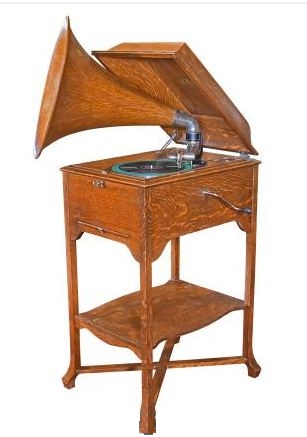 |
| Left: Victor “Schoolhouse” Phonograph with downward-directed horn? 1915
This shows the gramophone ready for action.
There is more information here.
|

BUDDHA-HORN GRAMOPHONES
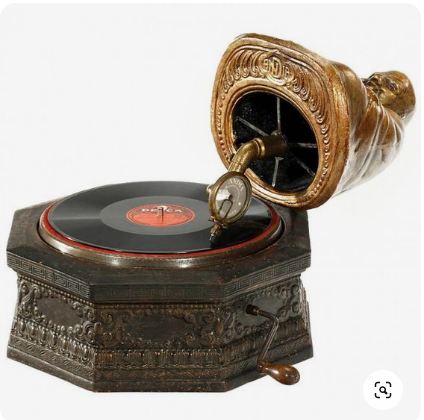 |
| Left: Buddha Gramophone: 1924
This bizarre gramophone was made by Buddha Phonographes Artistiques, around 1924. The inside of the Buddha appears to be used as a kind of folded or reflex horn. When not in use the Buddha hinges forward (presumably after the reproducer was removed) to cover the turntable.
It was patented in England and France by Gonzalez de Yrarrazazeel.
|
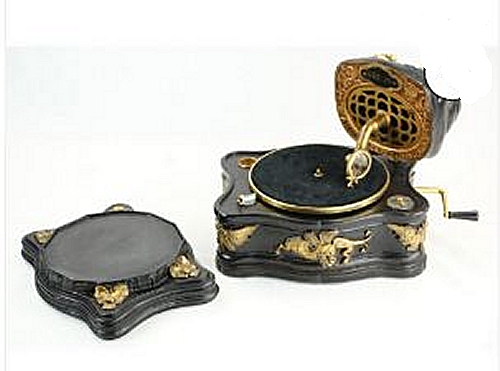 |
| Left: Buddha Gramophone: c1924
Another Bizarre Buddha gramophone has emerged; this one was made by the Andia Company of Paris and Brussels. It has a composition case and lid in Chinoiserie-style. The inside of the Buddha again appears to be used as a kind of folded or reflex horn. When the machine not in use as a gramophone, the Buddha sat on top (presumably after the reproducer was removed) of the plinth shown at left, which covered the turntable.
|

CONFUCIUS-HORN GRAMOPHONES
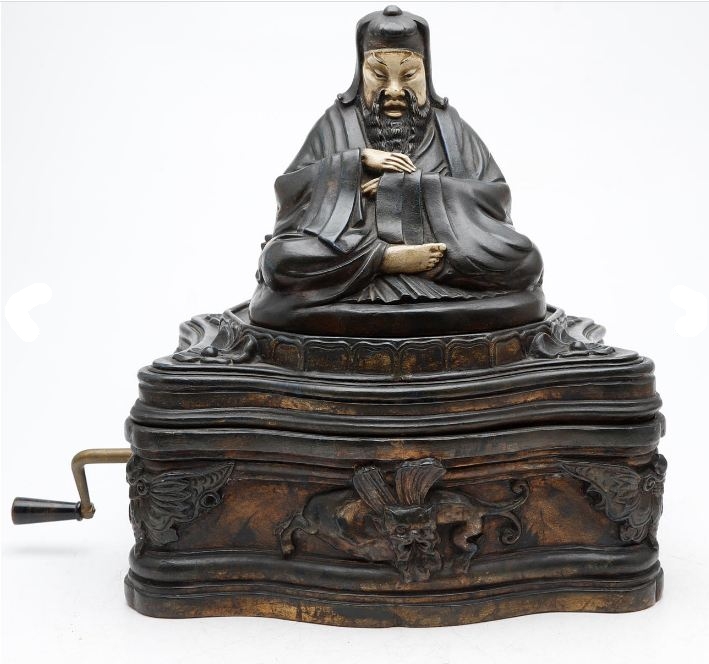 |
| Left: Buddha/Confucius Gramophone: c1924
This extraordinary machine was advertised at auction as a Buddha gramophone, though it looks to me more like a Confucius gramophone. It was made by Arton, a Spanish company.
|
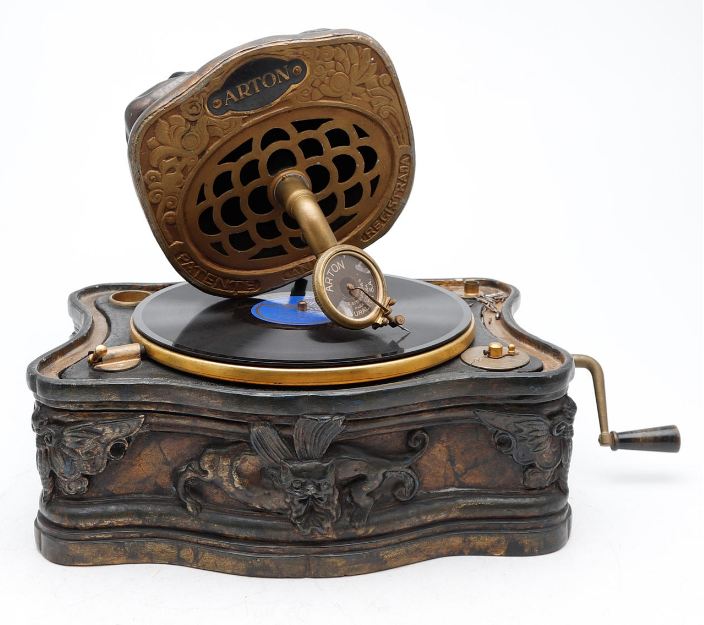 |
| Left: Buddha/Confucius Gramophone: c1924
Here the horn is shown resting on the record. I don't think that can be right.
|

THE LITTLE WONDER PORTABLE GRAMOPHONE
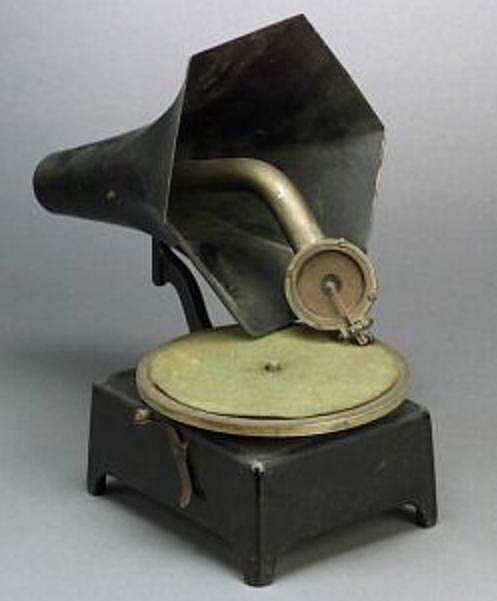 |
| Left: The Little Wonder portable gramophone: 19??
This gramophone has a cast-iron base, {Just how portable was it?) with a black reflex reflector horn and 7-inch turntable.
It sold at auction recently for $529
Note that again the horn is resting on the turntable, (see picture above) so some adjustment required.
|
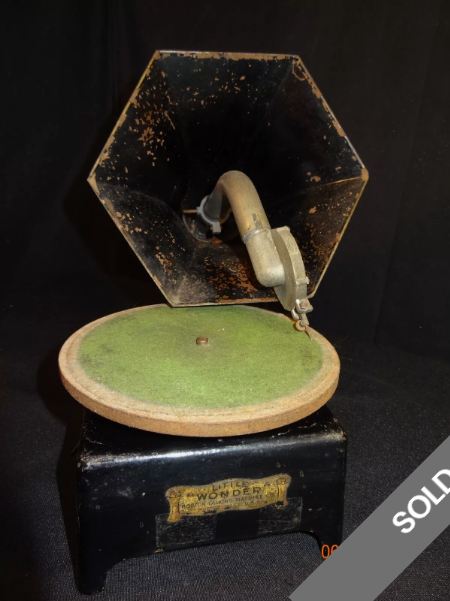 |
| Left: The Little Wonder portable gramophone: 19??
This is a different example, this one having a nameplate on the front. This view shows how the tone-arm was fixed to the far end of the horn.
It seems likely this was a toy gramophone rather than a serious one.
|
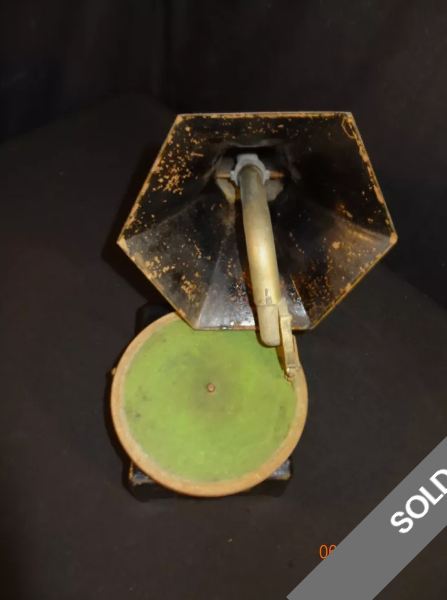 |
| Left: The Little Wonder portable gramophone: 19??
Another view of the tone-arm mounting. It appears that when you lifted the tone-arm, it swivelled on the rod at the inner end of the horn.
Since there would be some up-and-down motion when playing a record, the swivel end of the tone-arm must have been moving somewhat with respect to the horn, which may have provided some interesting acoustic effects.
|

THE GUINIPHONE PORTABLE GRAMOPHONE
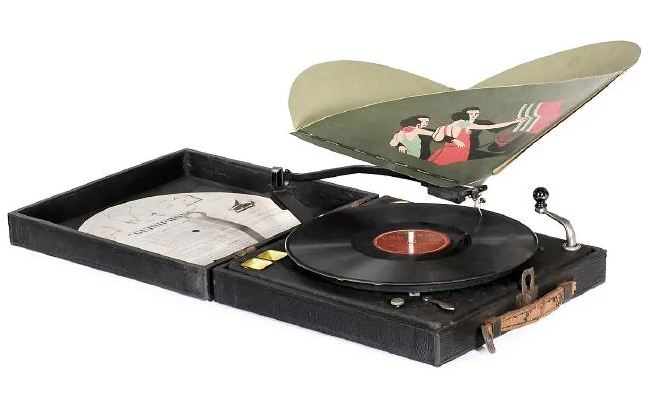 |
| Left: Guiniphone gramophone: 1930
The "Guiniphone" portable gramophone was manufactured by the Guinea Portable Gramophone Co Ltd, of 69 Farringdon Road, London EC1. It had a 9-inch turntable, a cast-metal tone arm.
Instead of a horn there was a polychrome-printed folding paper cone, driven at its apex by the needle. The case was leatherette-covered.
|

THE PATHE DIFFUSOR GRAMOPHONE
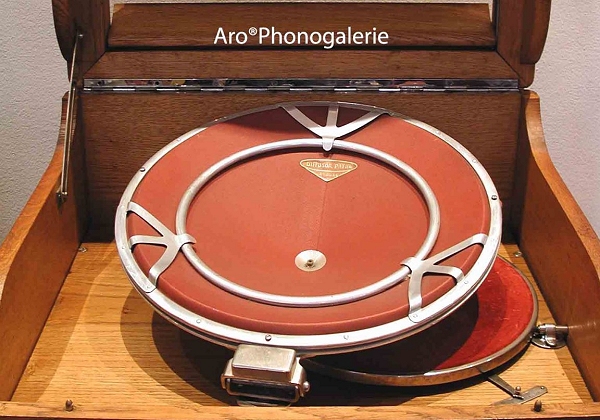 |
| Left: The Pathe-Diffusor Gramophone: 1921
The Pathe Diffusor used a cone very much like a loudspeaker cone. A needle was fixed to the apex of the cone, and played the record, the cone swivelling on the silver attachment at the front. The gramophone therefore has reproducer, tonearm, and horn combined in one; presumably the aim was cheapness.
This example is in the Phono Gallery at 10 rue Lallier, Paris, France. Not to be confused with the Phonograph Museum at 53 boulevard de Rochechouart, Montmarte, Paris.
There is more information here.
You can hear a Diffusor playing on YouTube. Sounds pretty dire. The machine being played is a Sapphire Diffusor Table-Top Phonograph, made in 1920 by Pathé Frères in France.
|

AN HMV MODEL 460 LUMIÈRE GRAMOPHONE
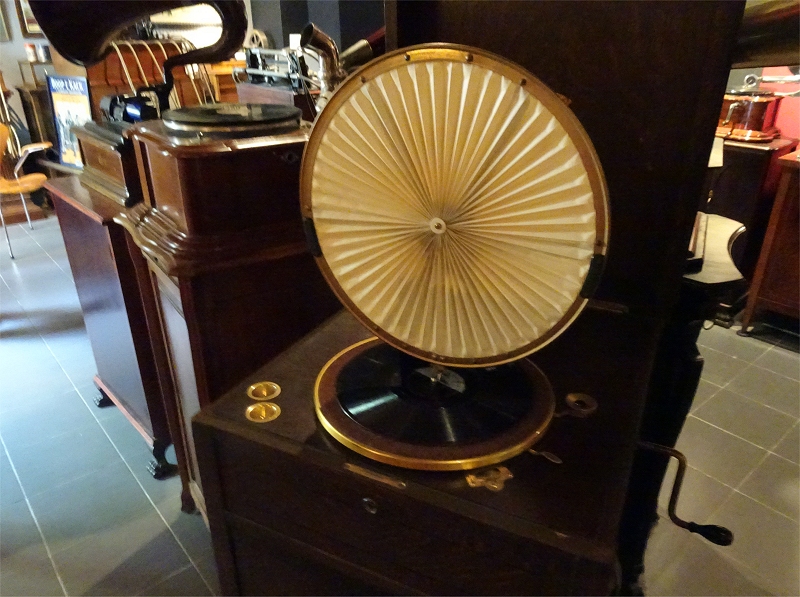 |
| Left: The HMV 460 diaphragm gramophone: 1924
This is another gramophone that uses a diaphragm rather than a horn to couple energy to the air; this is the pleated paper diaphragm invented and patented by Louis Lumiere, the French co-inventor of cinematography. The gramophone here is the oak cabinet version, with the diaphragm bearing the signature plaque, needle pots, lid stay, hinge, automatic brake and 12-inch turntable all in a gold plated finish. There is a transfer of Nipper inside the lid. It had a double-spring motor.
The Lumiere diaphragm gramophones made a very successful debut at the Piccadilly Hotel, London, on Wednesday 22nd October 1924, but they were expensive and the diaphragm was fragile and easily damaged, and sales were poor. One advantage was that the sound emitted was less directional than from a horn, and it was lighter and more compact.
Source: Author's photograph at the Phonograph Museum in Paris.
|

THE EXCELDA PORTABLE GRAMOPHONE
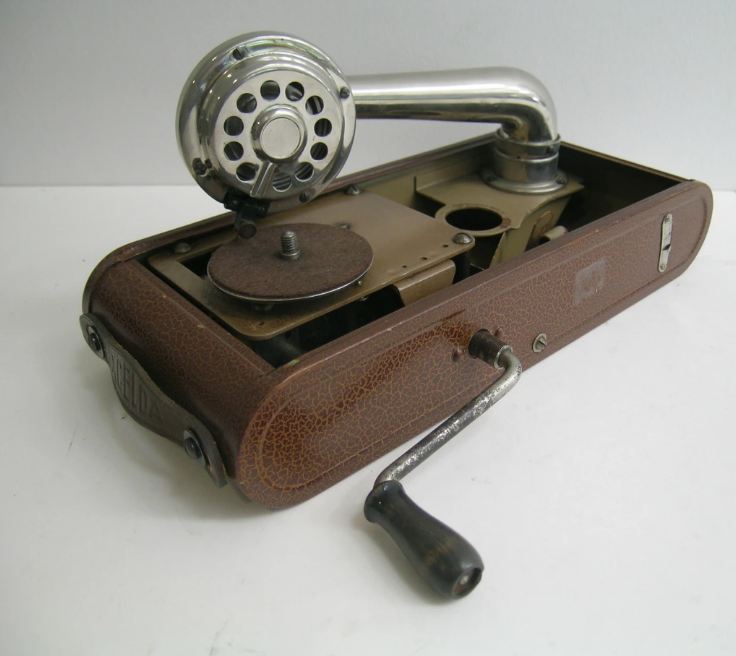 |
| Left: The Excelda portable Gramophone: 1930
The Excelda portable dispensed with a horn altogether, with the sound emerging from the holes in the reproducer housing. There seems to be no room for any internal horn of useful size inside the case, but this is not certain. It was manufactured by the Swiss company Thorens. It could accommodate 12-inch records.
There is more information here.
|

THE EDISON BELL PICTUREGRAM
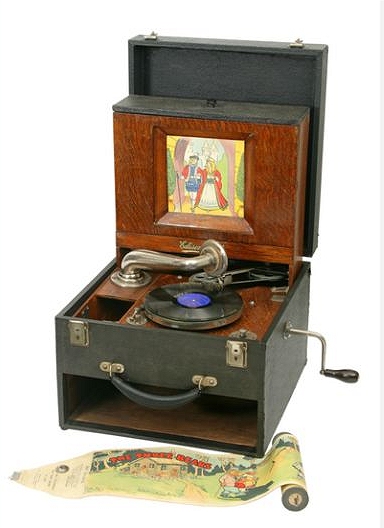 |
| Left: Edison Bell Picturegram: 1927
The Edison Bell Picturegram had a steadily scrolling length of paper that showed pictures synchronised (roughly) to the sound from the record. Its main application seems to have been relating nursery stories, one of them being Goldilocks & The Three Bears. The paper spool was rotated by a rubber-tyred friction wheel and a steel-spring belt, driven from the turntable, and just visible mid-right here. There is a spare picture roll in the foreground.
The scrolling screen could be removed and stored in the aperture under the turntable.
You can see a Picturegram working on YouTube, (Old King Cole now playing) and frankly it is a less than enthralling experience. Perhap I am jaded...
There is more info here.
|
 |
| Left: Edison Bell Picturegram: 1927
|

THE HUDSPITH STEAM-POWERED GRAMOPHONE
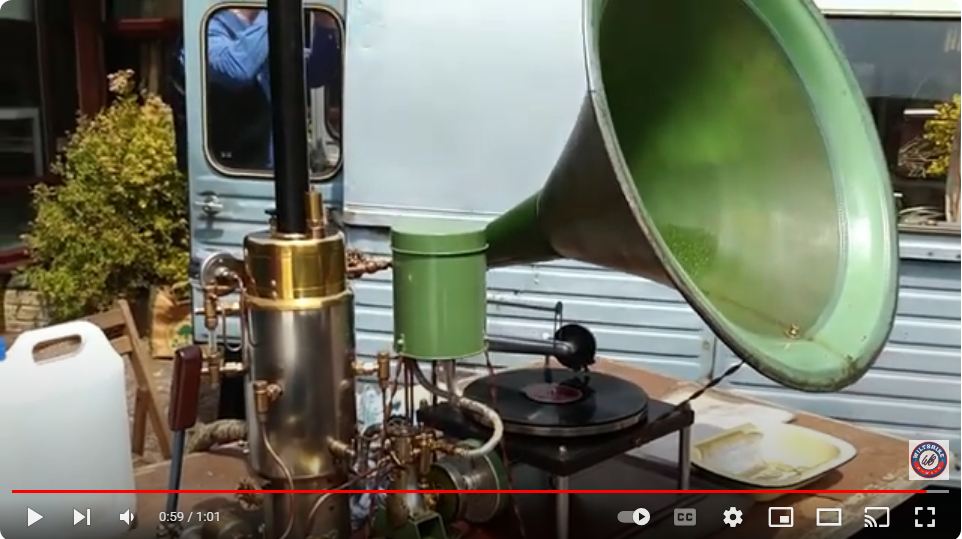 |
| Left: Hudspith steam-powered gramophone: 20??
This system was built by Geoff Hudspith. He exhibited it at Sammy Miller's Motorcycle Museum on 24 June 2018.
Mr Hudspith has Previous. He was the builder of a notable steam bicycle.
You can see the steam gramophone working on YouTube.
|

THE HUNTLEY STEAM-POWERED GRAMOPHONE
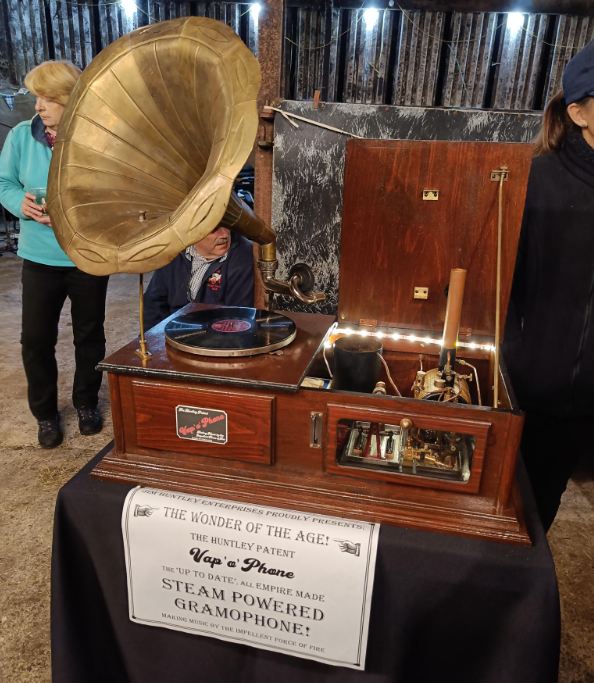 |
| Left: The Huntley steam-powered gramophone: 20??
This magnificent steam-powered gramophone was bulit by Mr James Huntley. He calls it the Vap-O-Phone.
You can see the steam gramophone working on YouTube.
|

THE FIRE-ALARM GRAMOPHONE
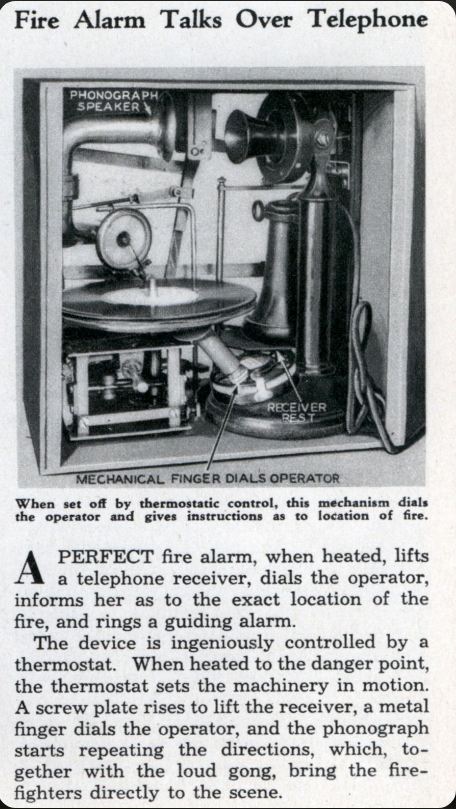 |
| Left: The Fire-Alarm Gramophone: 1920s
This ingenious device played a recorded message into the candlestick telephone when heat closed an electrical circuit.
There is a rectangular box between the tone-arm and the telephone mouthpiece; its function is unknown.
Source: unknown
|

THE BURGOT BURGLAR-ALARM GRAMOPHONE
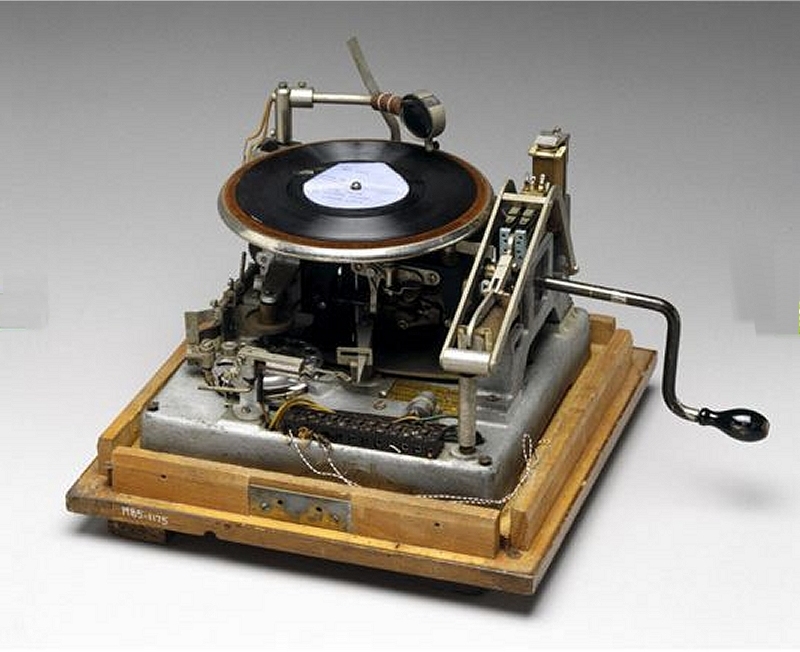 |
| Left: The Burgot Burglar-Alarm Gramophone: 1939
This is an early automatic burglar alarm. When activated by an electrical circuit, it dialled a preset telephone number and played the specially-recorded message to the police station at the other end of the line. It could be used to protect private premises, or as a silent bank alarm, activated by a floor-mounted switch. It was a considerable success because it used ordinary telephone speech lines rather than expensive hired special lines.
Note it had an electrical pickup, so the signal could be connected directly to the telephone circuit without converting it to audio. The GPO used to come down very heavily on people who wanted to connect their own equipment to the telephone system, so I suppose some sort of deal was made. The issue did not exist with the fire-alarm gramophone just above,
The records turned at 78 rpm.
I once worked in a factory in Shoreditch, London, (1980-82) which had a direct descendent of this technology, playing a record to the police when triggered. I think it was still working, but it was never used.
This example belongs to the Science Museum in London.
|
 |
| Left: The Burgot Burglar-Alarm Gramophone: 1939
The gramophone was normally covered with a wooden case.
There is a video of the alarm gramophone working on YouTube; go to 7:20. I was at Cambridge with Tim Hunkin.
There is more information here. The video shows that the gramophone incorporated a standard GPO dial; since dialling pulses have to be of standard speed and length this was probably a sound plan. The recorded announcement sounds very posh.
|

THE WORLD RECORD CONTROLLER
One of the many disadvantages of gramophone discs is that the linear velocity of the groove moving under the stylus is not constant. As the arm moves toward the centre of the disc the diameter is less so the groove velocity is also less. This means the signals cut into the groove walls are more cramped and distortion increases; it is usually called 'end-of-side distortion' and it is nasty. This problem remains today with microgroove vinyl discs.
 |
| Left: World Record Controller fitted to gramophone: 1922-26
An answer to this issue was invented by Noel Pemberton-Billing, when he was not making a nuisance of himself in other ways. He called it the World Record Controller. This sounds like it is some sort of Olympic committee but it is not.
The system comprised an auxiliary governor that could be retro-fitted to existing gramophones, and specially-cut discs. These were turned at 33 rpm rather than the standard 78 rpm, to give over ten minutes of playing time, much longer than the standard discs. This presumably gave Billing problems with 'end-of-side distortion' and so the auxiliary governor was designed to initially slow down the turntable and then gradually speed up the rotation as a disc was played.
The picture shows a rubber-tyred wheel resting on the record surface. It was coupled to a small fly-ball friction governor which can be seen just to the right of the wheel, which kept the linear speed under the wheel constant by braking effect as the wheel moved toward the centre of the disc, moved by a feedscrew. This feedscrew was turned by a worm and pinion, which was itself driven from a friction wheel coupled to the rim of the turntable. This is the small white wheel at bottom right of the picture.
Since the speed was much reduced from 78 rpm to 33, the existing governor in the gramophone did not act; it was not necessary to dismantle the gramophone to disable it.
|
The system only worked with the specially-cut World Records, which were expensive, and only a poor repertoire was available. For these reasons it did not thrive, even though it appears you could switch immediately back to standard 78 rpm discs simply by lifting the braking wheel from the disc.
Here is a demonstration of a World Record Controller on YouTube. The wow is horrible, and it is clear there are real problems with speed control, probably due to the braking wheel slipping on the disc surface.
 |
| Left: The World Record Controller: 1922-26
To the left is the worm drive for the feedscrew. The horizontal rubber wheel to drive it is missing; normally it would be between the two metal discs. The vertical lever engages with the screw like a half-nut, and can be disengaged by moving the upper half of the lever to the left, to prevent the arm moving when conventional records were being played and the Controller was not required.
The fly-ball governor presumably operated in the usual way by introducing more friction as the balls moved outward. Its shaft vanishes to the right into the brake-wheel housing, and the exact method by which it is driven is not visible; probably small helical gears.
The function of the small knob on top of the arm is unknown- perhaps it was just for lifting the arm.
|
 |
| Left: The World Record Controller: 1922-26
This is a close-up of the top picture, showing the Controller mounted on a gramophone.
|
 |
| Left: The World Record Controller: 1922-26
|

THE GRAMOPHONE DANCER
 |
| Left: Dancing figure powered by gramophone: 1915
It seems unlkely that anyone would devise a toy that required a gramophone to work, but they did. This dancing figure was activated by gearing from the turntable, supported by wire outriggers. The figure turns around and is moved up and down by a central pole, its pivoted limbs flailing and feet clattering, while the record plays. The figure seems to represent a negro minstrel, but it seems unlikely this was conceived as a means of disrespecting black people. I could be wrong.
Image quality is poor because this is a still from a video. You can see the whole video here. Frankly the entertainment value is limited.
|

GRAMOPHONE WITH DANCING COUPLE
 |
| Left: Gramophone training of dancing couple: 1907
This is a Klingsor gramophone with a dancing negro couple moulded in coloured bisque, performing in a mirrored compartment. There are strings stetched across the overhead horn mouth for resonating, though it is not clear to me why that should sound better. The light oak case is 35¾in. (91cm.) high.
The Klingsor Gramophone was invented in Germany in 1907. They were sold in the Great Britain through the Murdoch company, who were still offering these machines in the 1920’s.
There is more info here.
Hmmm. Negro dancing again. Was there some perception then that black people were better dancers than white people?
|
 |
| Left: Gramophone training of dancing couple: 1907
This elegant Klingsor model with stained-glass windows has dancing figures all in white, and many more strings across the horn mouth.
|

THE GRAMOPHONE TANK
 |
| Left: The Gramophone-Controlled Tank: 1934
I think this is a good candidate for 'Least Practical Application of a Gramophone'. While the system may work as described, it is fatally dependent on the battlefield being totally unchanging while you cut the control records. Were you supposed to cut new records right out there on the battlefield?
“No plan survives contact with the enemy” is the famous quote from Helmuth von Moltke, (1800–1891) a Prussian military strategist and field marshal.
There is no hint of feedback or gyro-control of direction. Where the tank goes will depend on the ground conditions etc etc. This is plain daft; radio-control might be a somewhat better bet but I don't think there have ever been full-size radio-control tanks.
Source: unknown but probably Popular Mechanics. Must have been a slow week for real news.
|

THE PARROT-TRAINING GRAMOPHONE
 |
| Left: The gramophone training of parrots: 1935?
So far as I know there is nothing unusual about the gramophone here, but it is certainly being used for the unusual purpose of training parrots to talk, and anyway I like the picture.
It was 'found on the net' and the only accompanying info was that it was taken in Germany in 1935. I don't buy that- the little notice says Defense toucher perroquets which is clearly a warning in French not to touch the livestock. (because you'll probably get bitten)
The French location is confirmed by the writing on the wall: 'Ce mur n'est...' meaning 'This wall is not...'. Not a wall, perhaps, if Rene Magritte has been around.
Also, the collar and tie look more like 1895 than 1935. There seems to me to be a mooring ring at lower left, and from the general look of the scene it seems very possible this was taken on the banks of the Seine in Paris.
|







































































































